Star Atlas: Next Generation Gaming Metaverse
Star Atlas is a next-generation metaverse project built on the Solana network and is one of the most ambitious projects in the gaming and metaverse scene that I have ever seen. Star Atlas is more than just a blockchain gaming metaverse; it is an entirely new, fully immersive virtual solar system with multi-dimensional play to earn mechanics and a robust, fully functioning economy that could change the world as we know it back here on planet Earth. Star Atlas borders on science fiction, the likes of which we thought was still decades away or only possible in films.
The project is certainly turning some heads and has people talking already with thousands of tweets, re-tweets, Reddit discussion forums, Discord chats, and a massive fanbase, along with a line-up of investors and VCs waiting in anticipation for a game that hasn’t even been fully launched yet as the complete product is still a few years out.
Disclaimer: I hold the in-game ATLAS and POLIS tokens as part of my portfolio.
What is Star Atlas?
While the game is still under development and we are left imagining what the game may look like in its final form, we can tell a lot from the team's massive 42-page whitepaper and 38-page economics paper. The game has attracted attention for its utilization of DeFi and NFTs, along with its incredible concept art, cinematic trailers, and screenshots that all look amazing. We know that the team is working with the Unreal 5 gaming engine to create hyper-realistic, life-like gaming graphics. In addition, we can gather quite a bit of information about the game from the pre-launch mini-game and the multiple interviews with the CEO Michael Wagner as well. Here is all the information I've been able to gather so far.
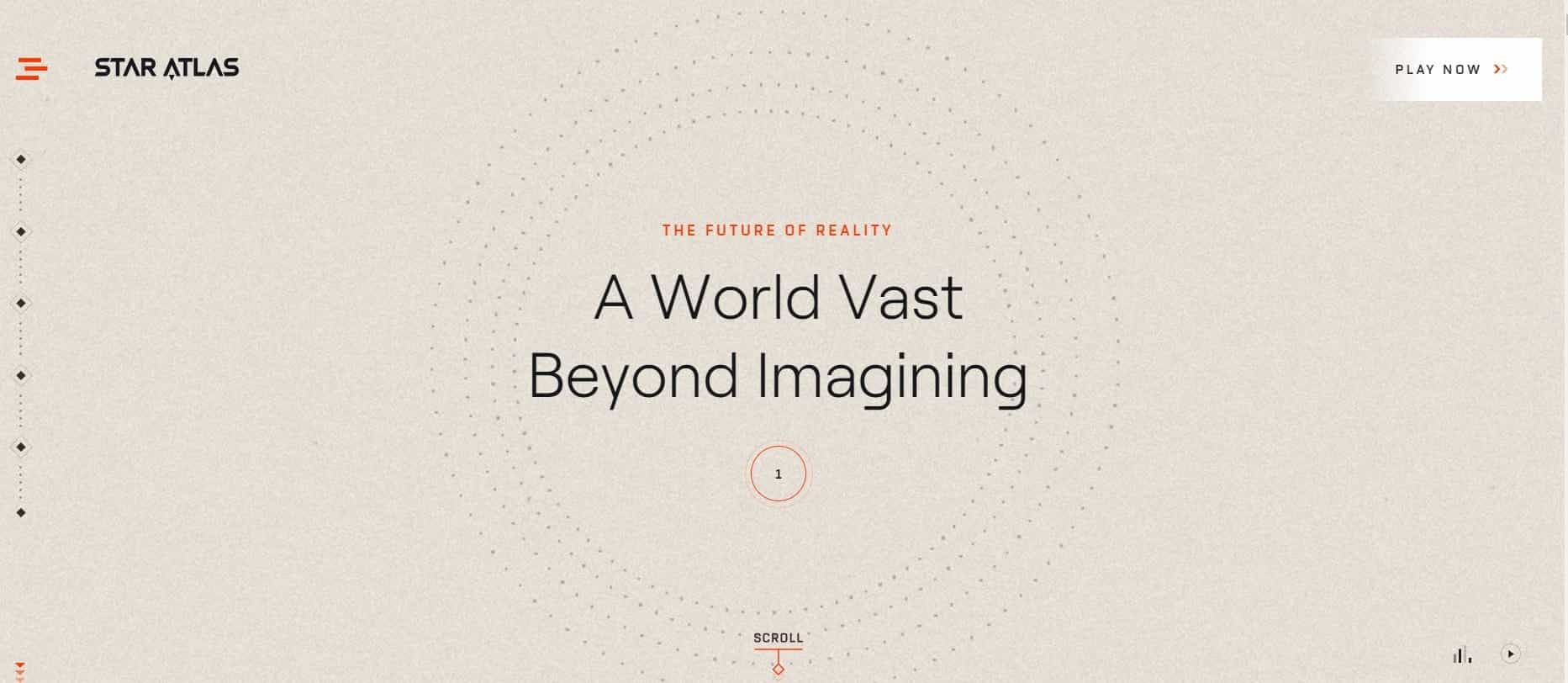
Star Atlas is a massive multiplayer online role-playing game (MMORPG) that will allow players to essentially reimagine the future and destiny of humanity, laying the foundation for a socioeconomic, political, and financial system for the future. I must say, that sounds pretty intense and intriguing. I guess there can be more to video games than dressing up as a plumber and smashing bricks for coins.
The developer team aims to usher in a new era of how we live and work inside a metaverse, creating the next generation of economics and governance by creating a virtual realm that will eventually be run autonomously, purely owned by the community. The goal is for this Metaverse to become completely self-sustaining while being controlled and funded through decentralized governance. If the concept of decentralized governance is new to you, check out Guy's video on everything you need to know about Decentralized Autonomous Organizations (DAOs), and to understand more about Metaverses, we also have a Complete Guide to the Metaverse.
A quote from the Star Atlas CEO states:
“Star Atlas has been designed since inception to empower a new generation of gamers, creators, and dreamers to rebuild the world to alternative constructs and standards. A true digital Rebirth of the human species. We choose to build a metaverse and MMO embodied by true self-sovereignty. The vision for which would be impossible individually, but inevitable collectively.”
Wow, that is a heck of a statement.
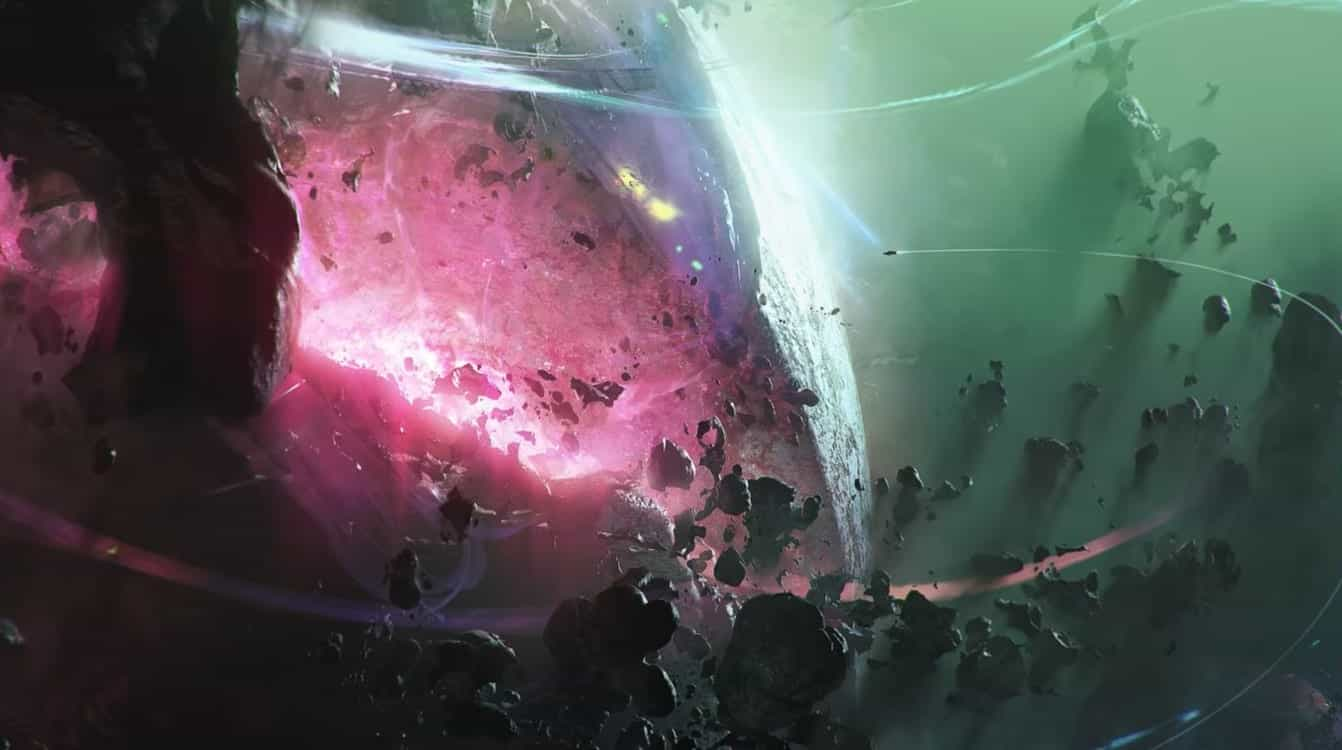
The massive multiplayer space-themed metaverse gameplay will include the ability to perform things like deep space and planetary exploration and fight for world dominance through war or peaceful political takeovers and alliances by joining factions and guilds. In addition, players can start their own decentralized autonomous organizations or just explore the galaxy, going on adventures while finding and creating NFTs to build their virtual empires. NFTs will make up things like spaceships, buildings, land, mining materials, farming materials, clothes, and businesses; pretty much of what exists in real life will exist in Star Atlas in the form of NFTs.
Leveraging blockchain mechanics, Star Atlas players can participate in play-to-earn, peer-to-peer, and decentralized finance activities through a unique in-game interface. Users can access the decentralized marketplace functionality simply by connecting their Phantom Solana ecosystem wallet.
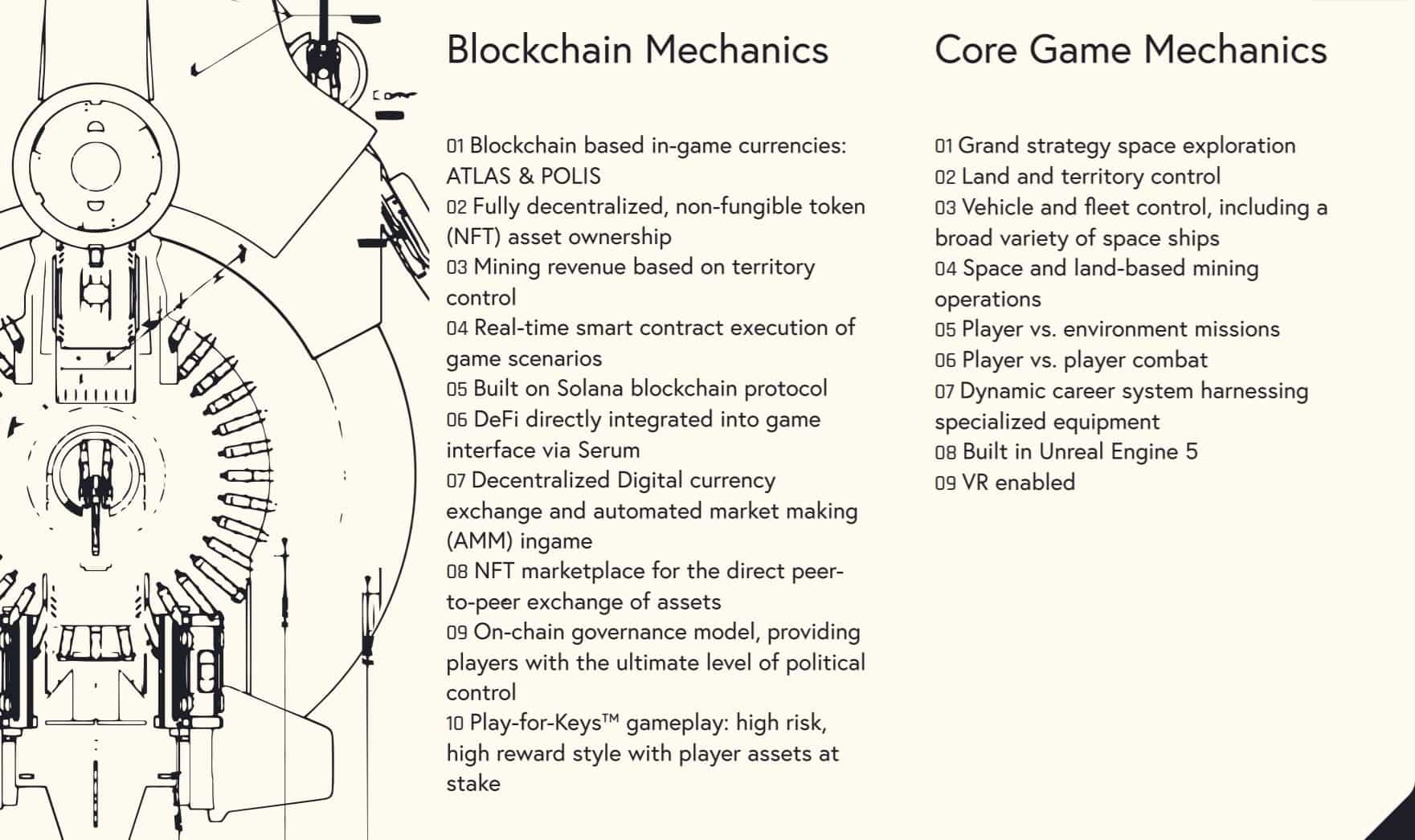
As seen above, the game mechanics are broken into core and Blockchain mechanics.
Choose Your Side
The game takes place in the year 2620, and three main factions compete for resources, territories, and political control. First, there is the MUD territory that is controlled by humans:
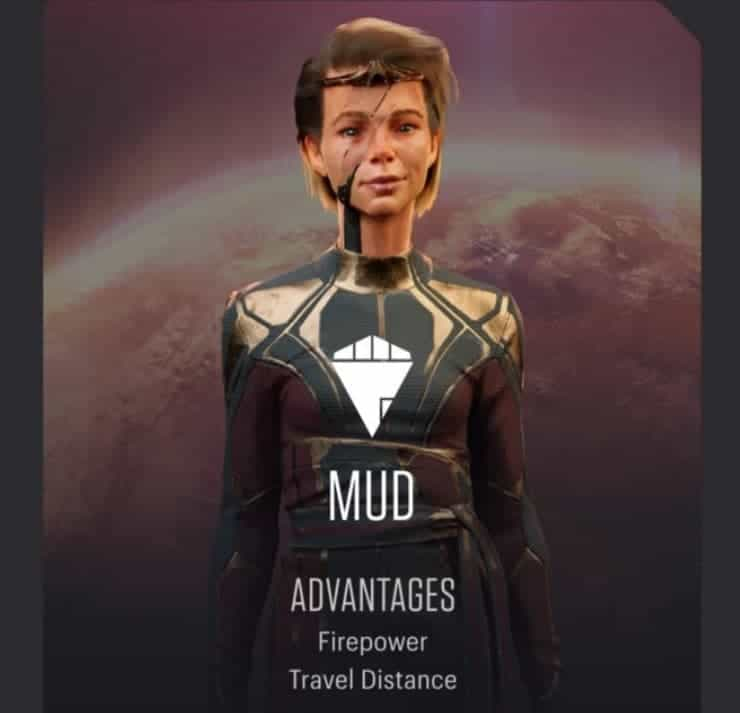
Then the ONI region run by these handsome fellows:
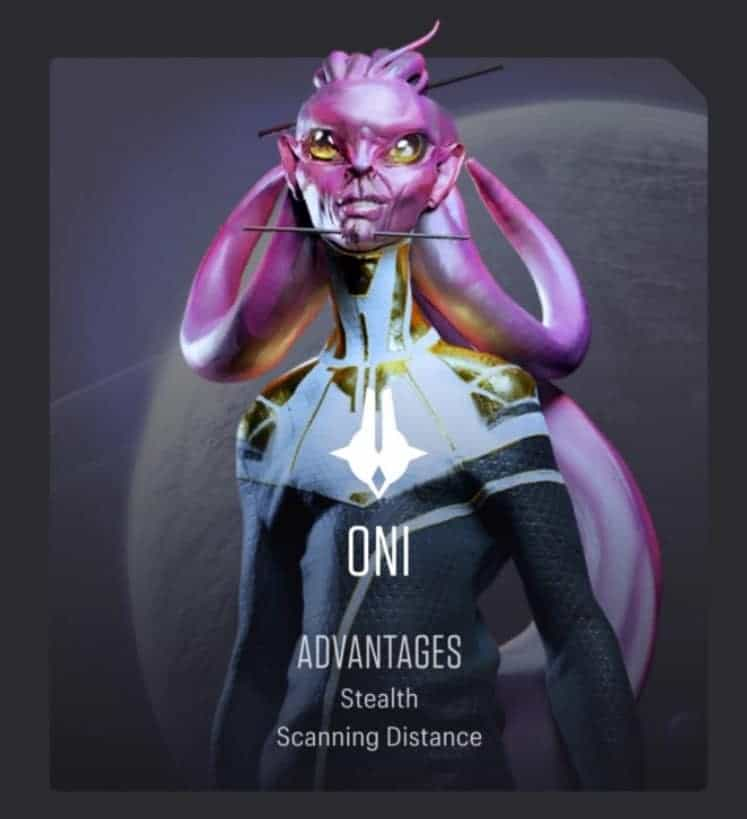
And finally, the Ustur sector, run by sentient cybernetic beings:
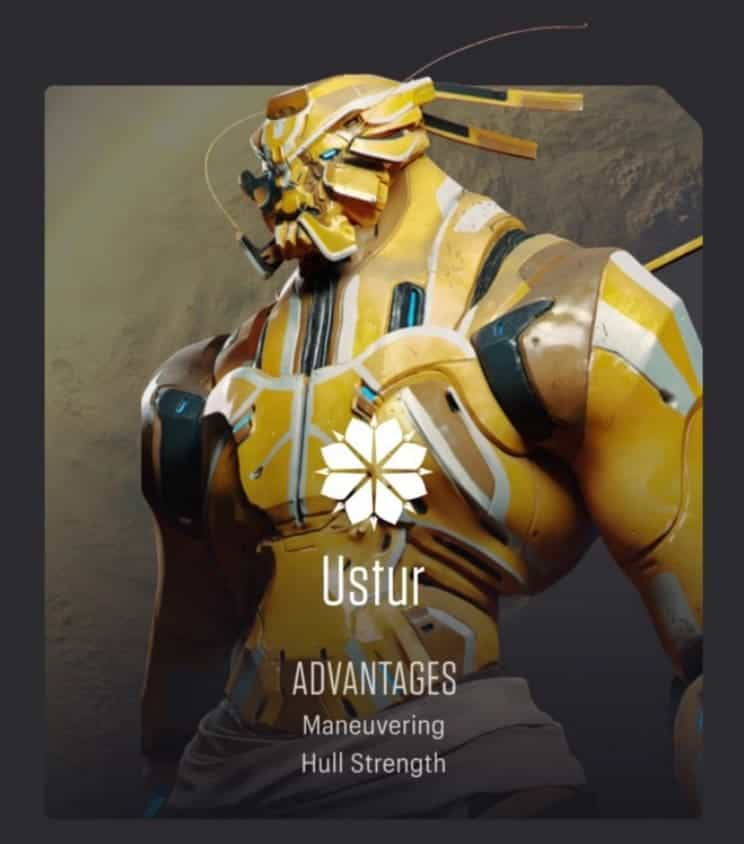
Each faction has strengths and weaknesses, and the locations of these nations will determine strategic advantages based on the production potential of what nearby raw materials are available. Players will be able to join other nationalities through passports, and each player’s earnings and accomplishments will help their nation’s overall leaderboard rankings. The Star Atlas website has a full breakdown of each faction’s strengths and weaknesses which you can read to find more.
Tip: Before choosing a faction, it may be a good idea to find which DAC (Guild/Clan) is best suited to your goals within the game because once you choose a faction, you cannot join a DAC that belongs to another faction. Be sure to have a look through all the different DACs/Guilds, before deciding.
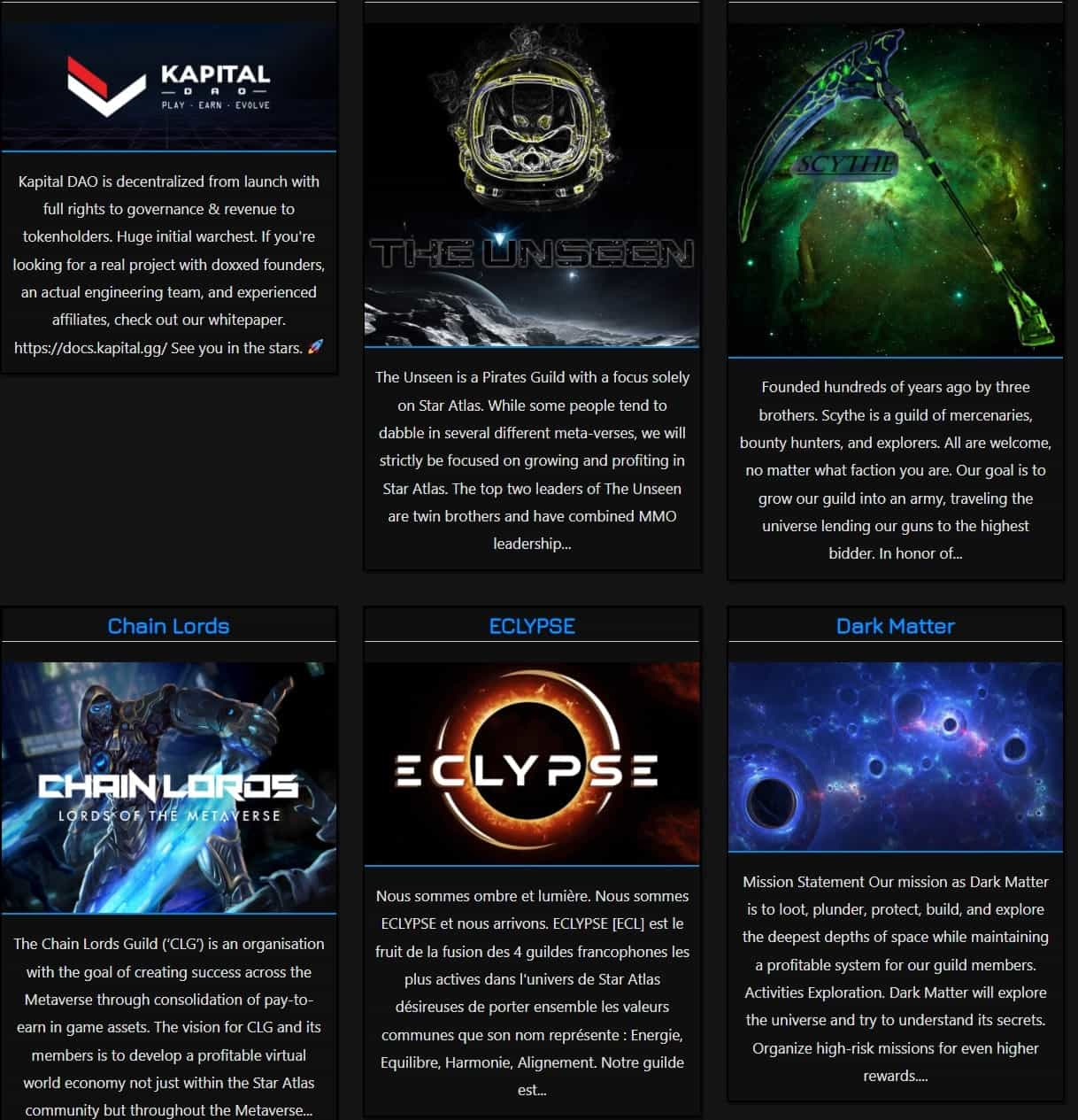
There will also be a feature within the game known as “Salvage Wars,” where players will be able to bid on containers full of salvaged assets, similar to loot boxes in other games. The contents of the containers will be unknown before purchase, though the weight of the container and the likelihood of quality content will provide clues.
The Role of NFTs
As with any good metaverse, the role of NFTs will be massively important in this game. All in-game items from ships, ship parts, weapons, crews, components, land, structures, resources and even pets will be NFTs, making them unique to each player and tradable or sellable in the Star Atlas NFT marketplace. Additionally, players will be able to own and sell land, which we have already seen how insanely profitable this can be from metaverses like Decentraland and the Sandbox.
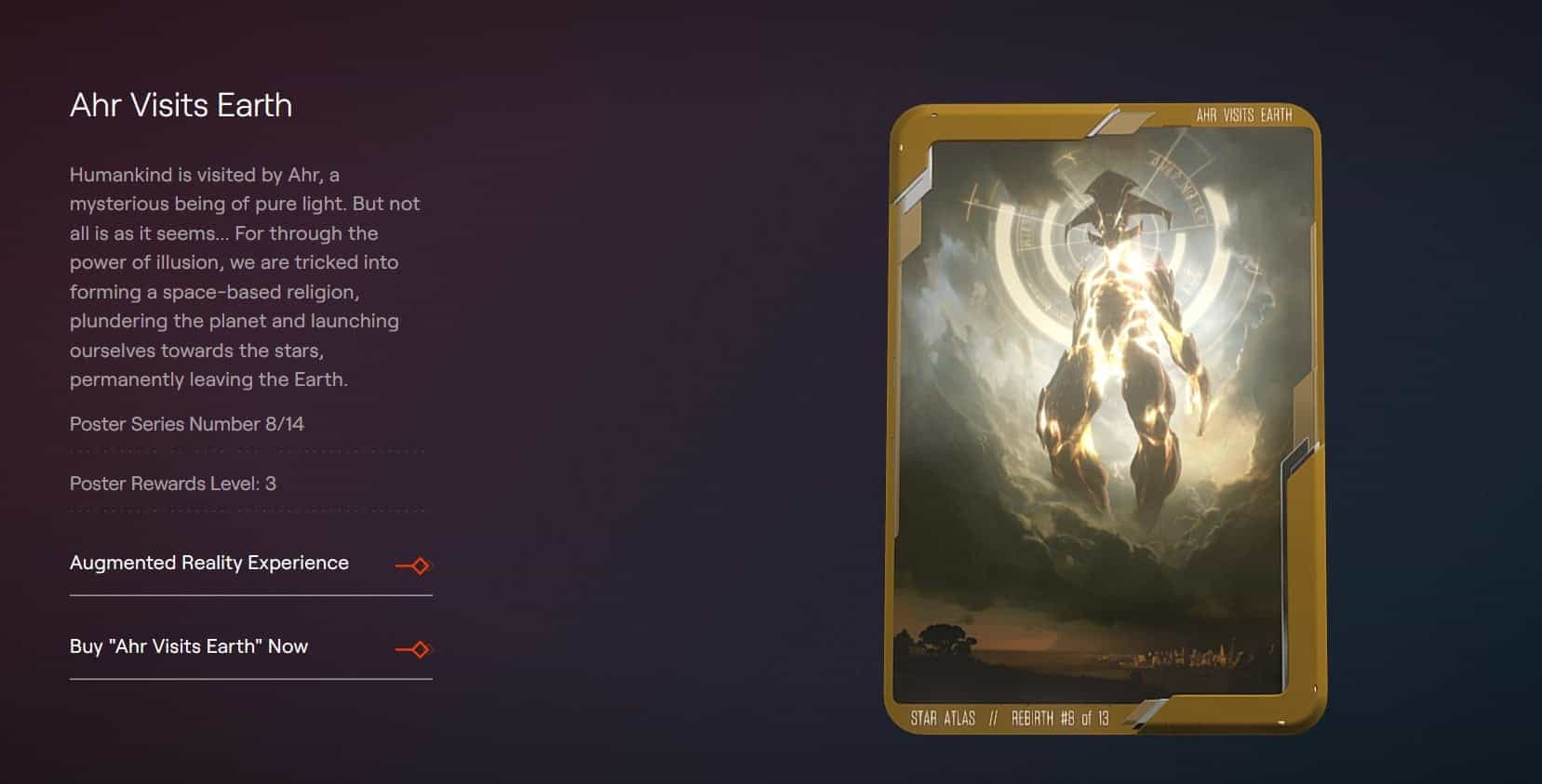
Some in-game items such as Spaceships, posters, and characters are already being traded on the Star Atlas marketplace, which will be ever-expanding and evolving to meet the growing needs of the Star Atlas universe.
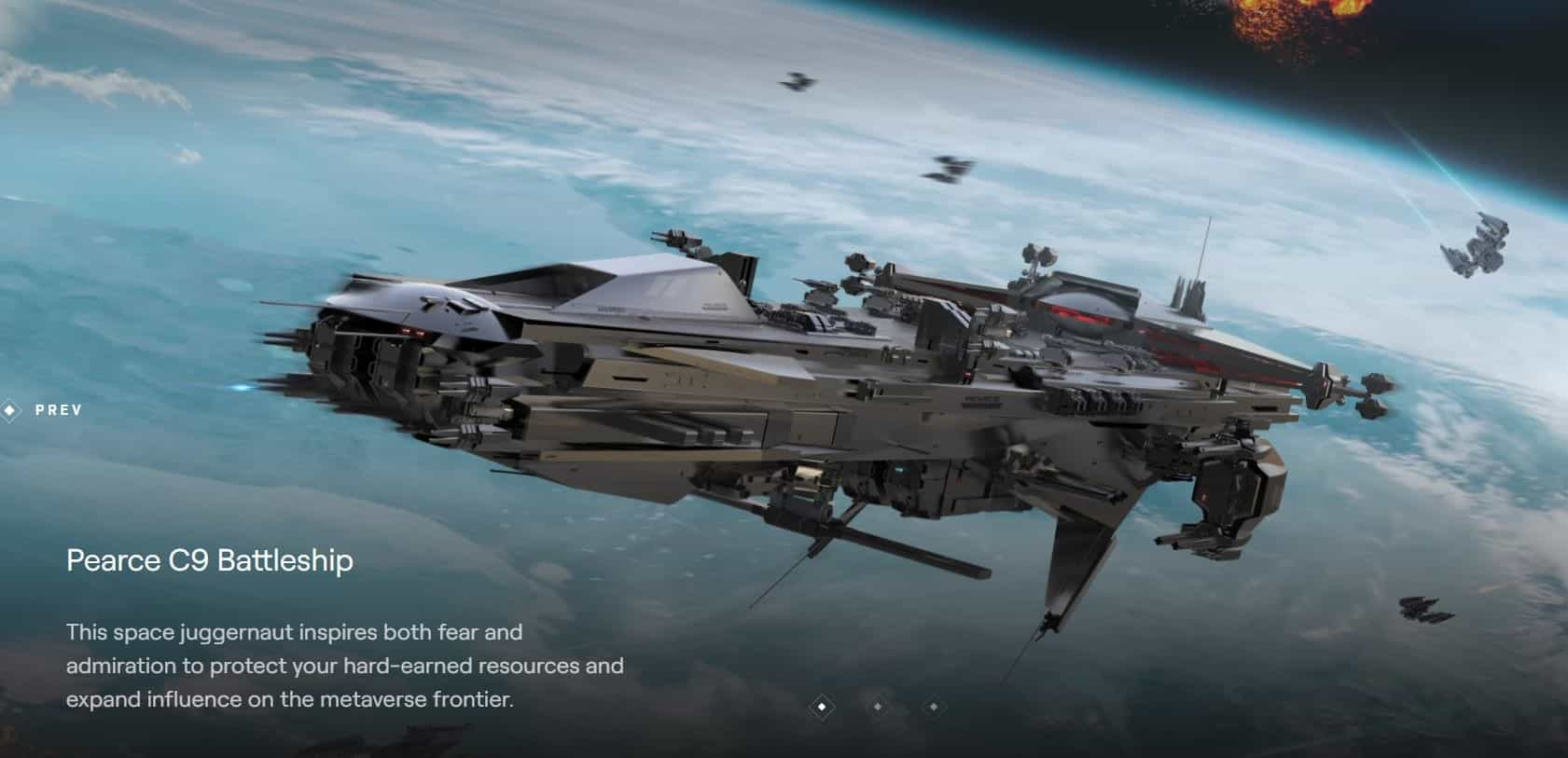
Galactic NFT Marketplace
The Star Atlas NFT marketplace, aka “The Galactic Marketplace” as it was so appropriately named, is currently live and in use, seeing increased use and adoption as early players and traders are building their ship fleets for use in the already launched mini-game and in preparation of the full game.
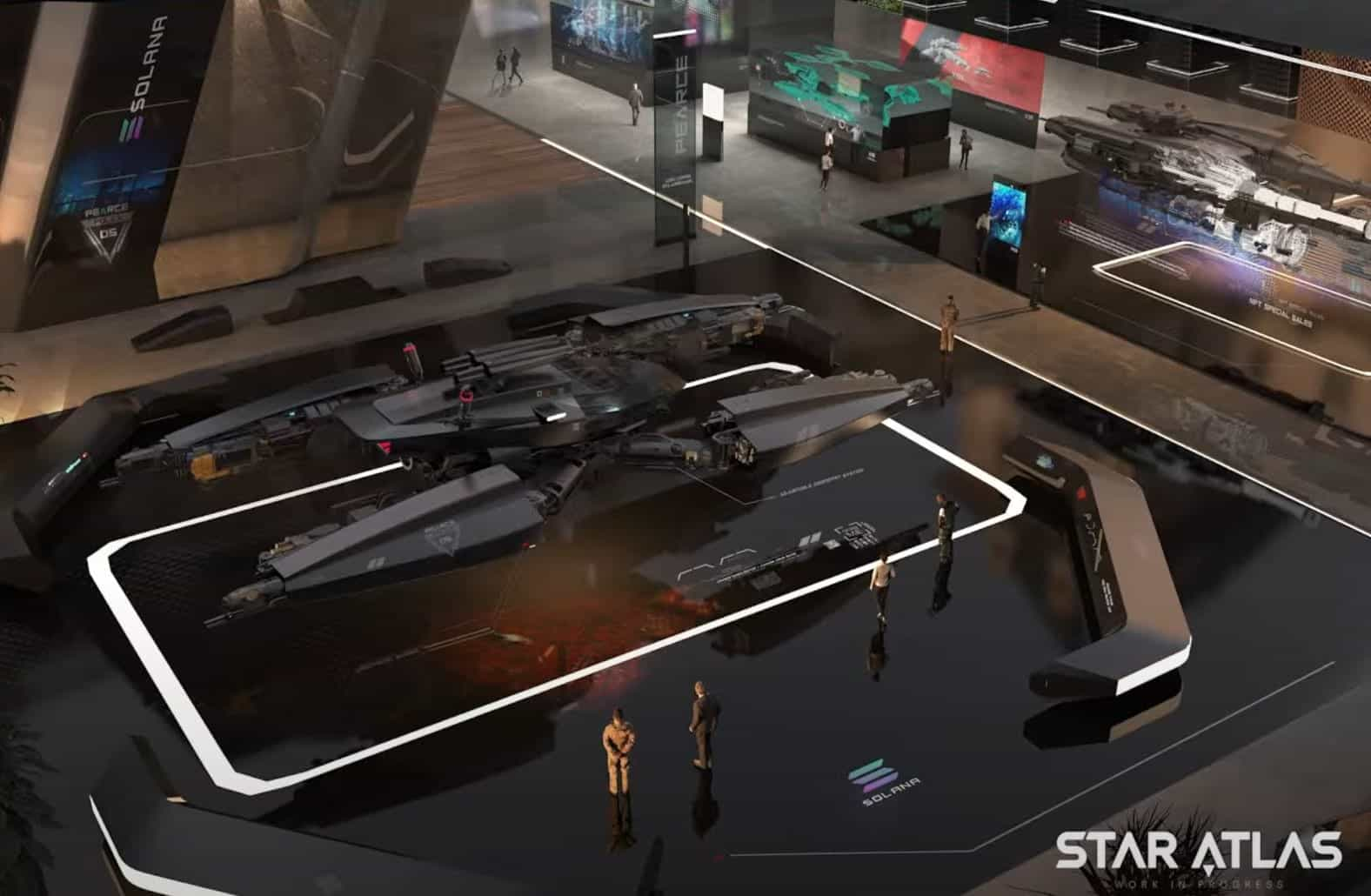
There are already over 20 ships available that players can purchase on the NFT marketplace. The team will be releasing more ships periodically leading up to the full launch of the game. There are over 140 different types of ships anticipated to exist within the game.
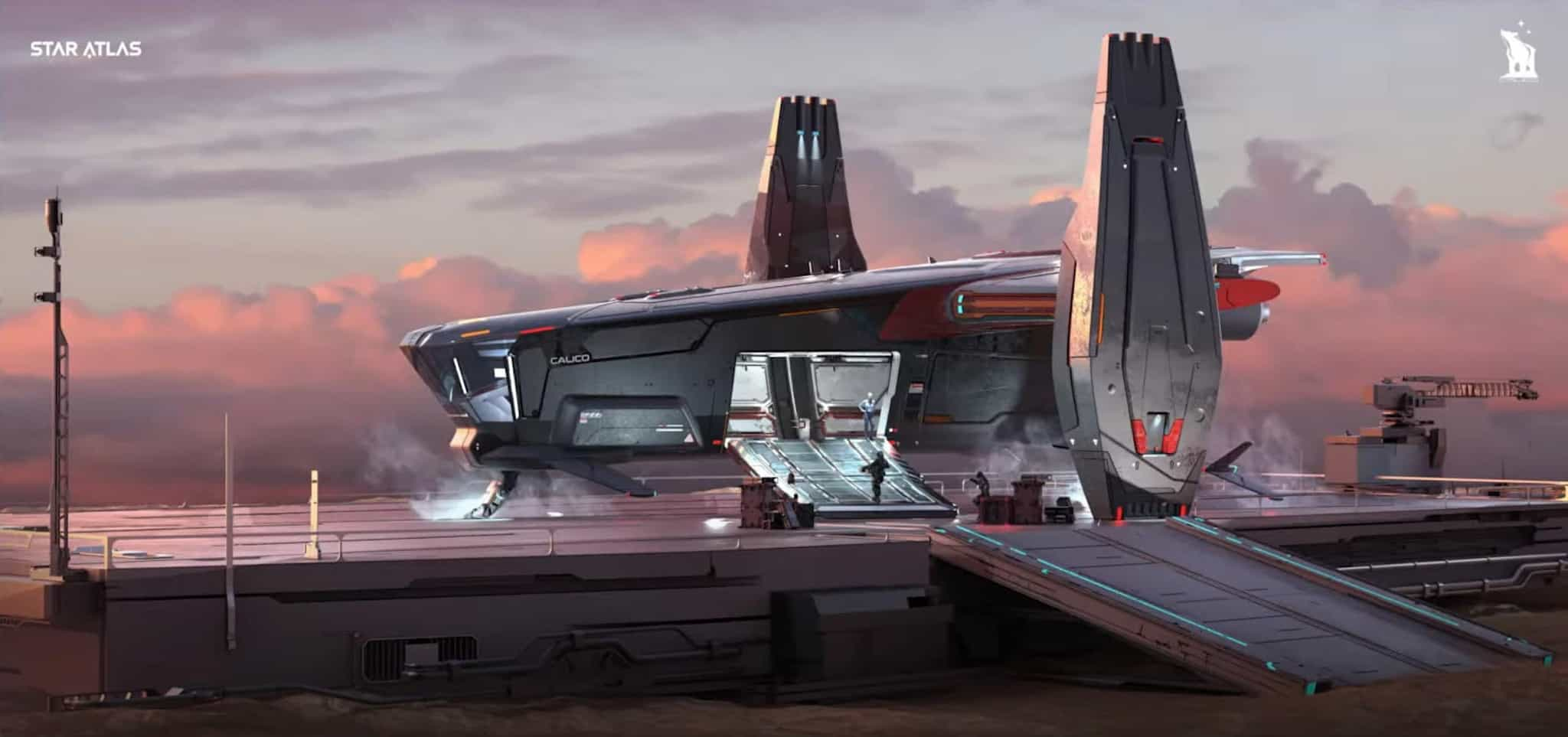
Some of the Utility NFTs will include things like:
- Ships, ship components, parts etc
- Crew Members
- Ship Modifications
- Weapons, Weapon Modifications
- Shields, Engine components, Thrusters
- Land
- Mining and Farming equipment
- Buildings and Structures
Fortune Favours the Bold
This game is going to feature some seriously high stakes. There will be space battles resulting in players losing huge amounts of money from having their ships destroyed and the spoils collected by the victor. It is plausible that some players will be sinking six figures or even millions worth of real monetary value into their space fleets, militaries, mining sites, and fortifications, and these can be wiped out in a losing battle. Like in real life, the outcome of battles will make and break fortunes.
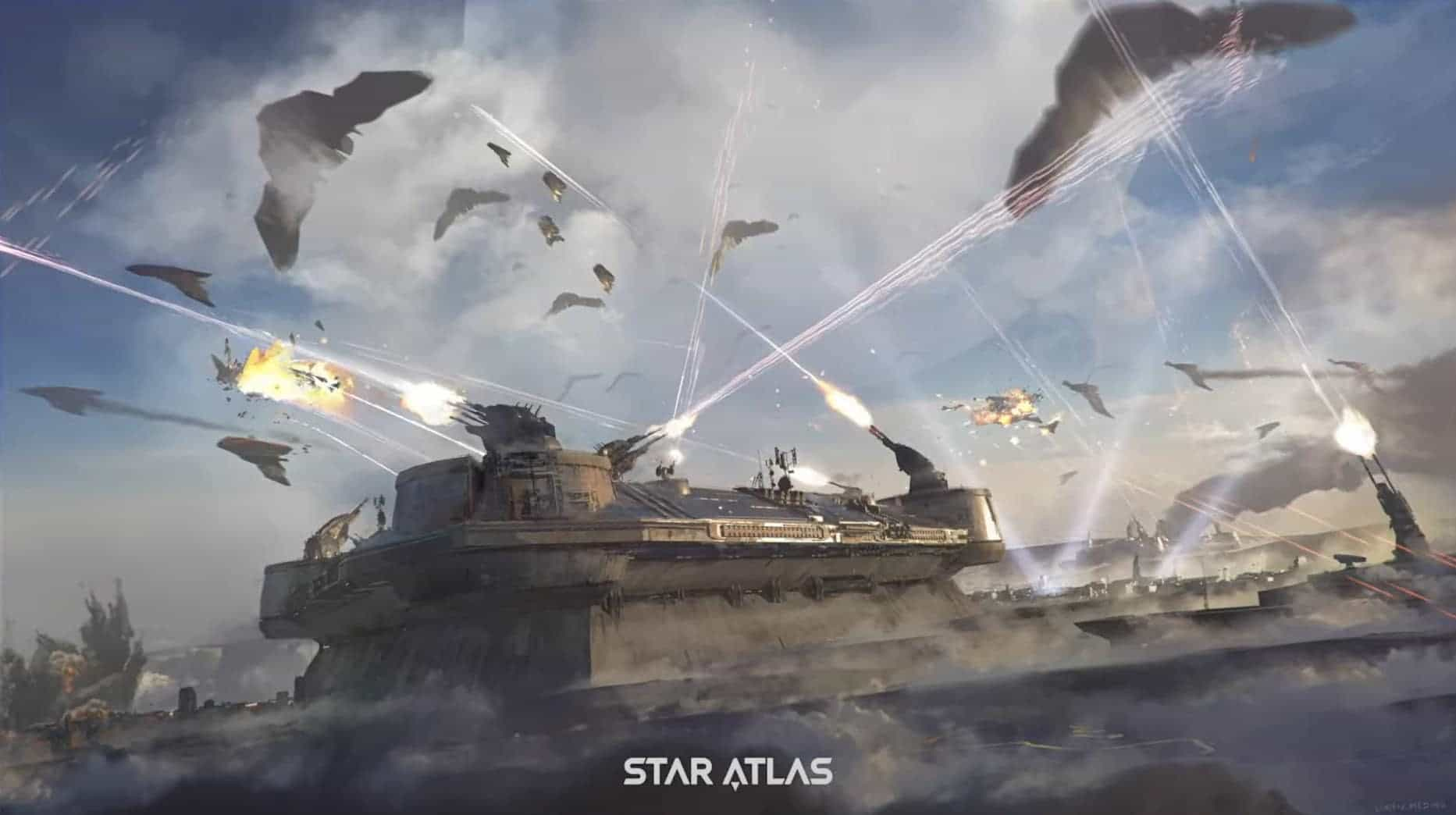
Fortunately, for those more risk-averse, one thing I really like about this game is that there are going to be three zones where players can hang out and play, each zone weighing out risk vs reward. The safe zone will be suitable for players who aren’t up for a brawl or who need to take a break and do things other than warmongering. Then the danger zone will be for those who want to go for the home run grand slam and risk it all in an “all-in” style of gameplay.
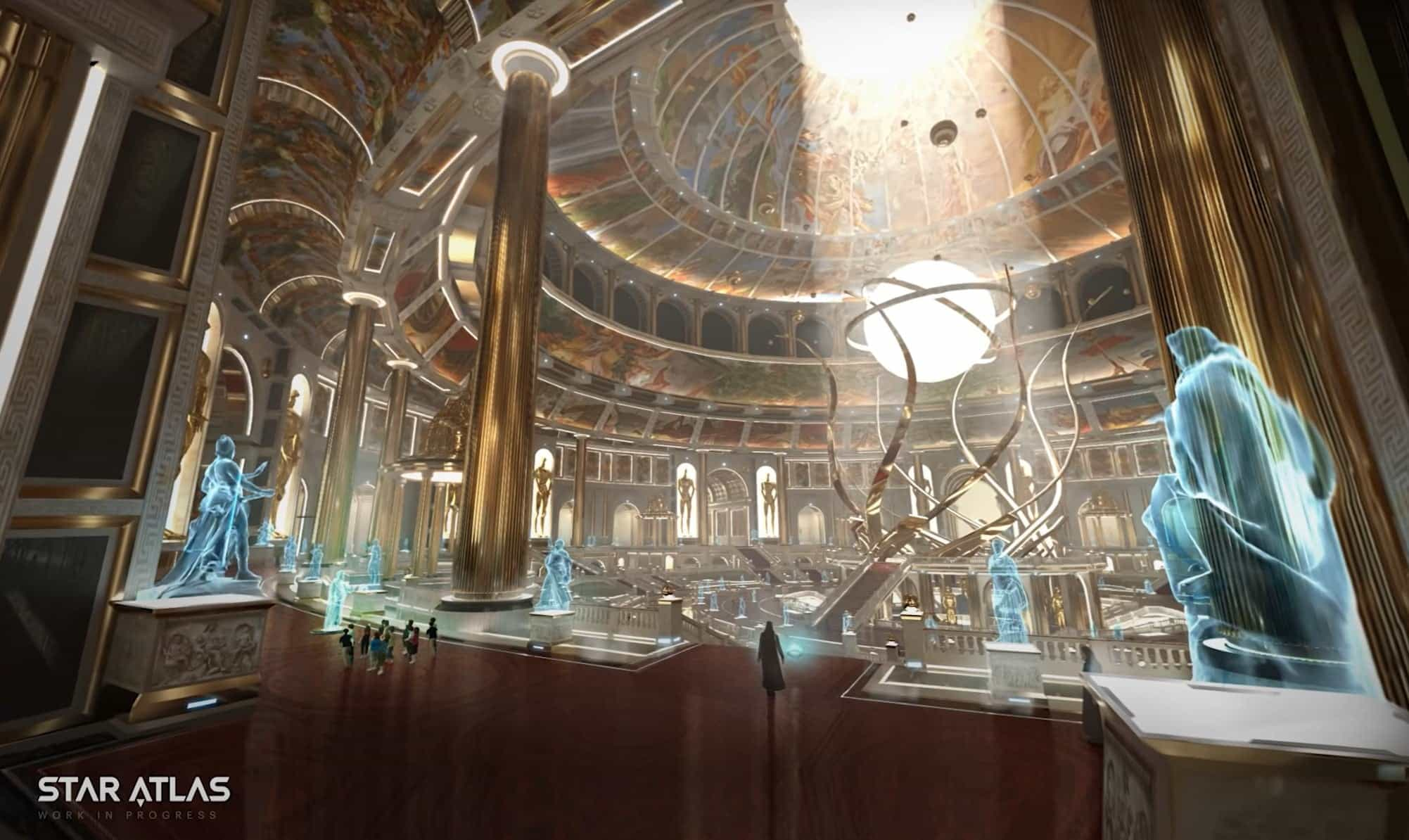
The safe zone is where players begin their journey where no PvP combat is allowed. This is where players can get the hang of things, gain experience and perform non-war-like tasks. These are the areas where players will be able to casually chill, explore, shop, decorate their living quarters, enjoy the amazing graphics and enjoy risk-free gameplay.
Then there is the medium zone where combat is allowed, and any destroyed assets will be returned to the player. Players will have the chance to rebuild and try again without losing their assets/NFTs.
Then finally, we get into the danger zone. The truly bold can venture out into deep space, and battle other players in a winner-take-all style of combat. Out here, any equipment such as ships or weapons that get destroyed are lost forever, and the victorious player can collect the wreckage of the defeated party. Each salvageable part will be an NFT, and the winner can sell them or use them as they see fit to fortify their fleet. The further players venture out, the better the rewards, but the greater the risk. Deep space will also be where the best mining materials are found, so be prepared to defend your land and colonies if you build in the danger zone.
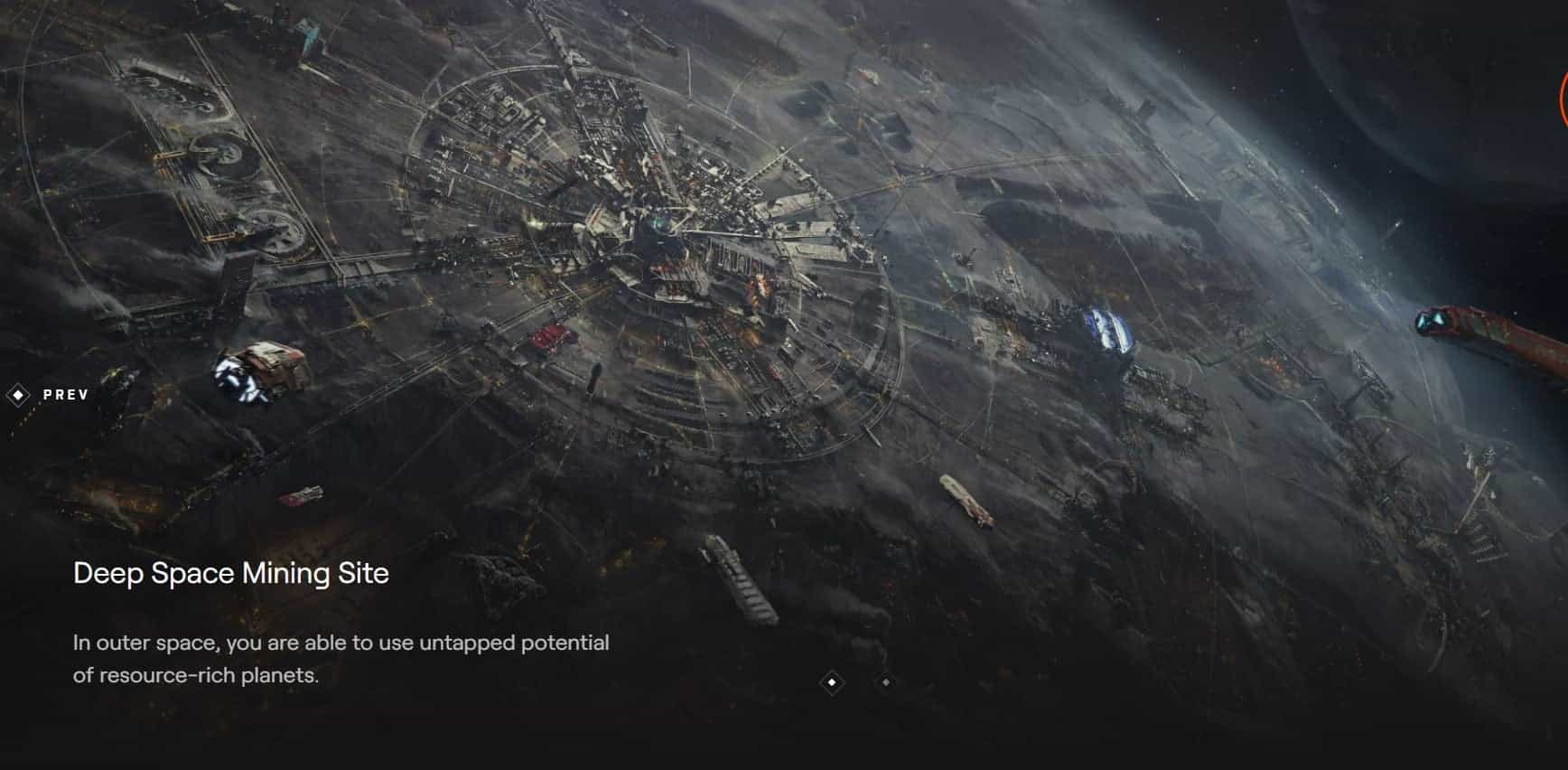
Naturally, ships will be outfitted with weapon turrets featuring different components and weapon types. When a player encounters an enemy ship, they will be able to perform scans and target subsystems to gain strategic advantages. Both land and space-based installations can be attacked, and all players can mark their stance as aggressive or passive to signal their willingness for battle. Setting your ship to passive will provide a shield and manoeuvrability buff to allow for swift escape if attacked.
Okay, deep space exploration and space battles sound cool, but what if war isn’t your thing? Well, this game has you covered. This article barely scratches the surface of everything that players will be able to do in this game.
Make Peace, Not War
If you don’t want to suit up for battle, players can explore and hang out on distant planets doing things like mining for resources, enjoying a drink in a tavern built on an asteroid with friends, farming, heck, why not become a space pirate, or a politician, a pilot, a janitor, a builder, or just go around running amok with no goal or destination in mind? Simply exploring is what I am looking forward to. It will be like Skyrim all over again, where I clock hours of gameplay, barely touching the main storyline as I’m forever skulking around all the nooks, crannies and caves.
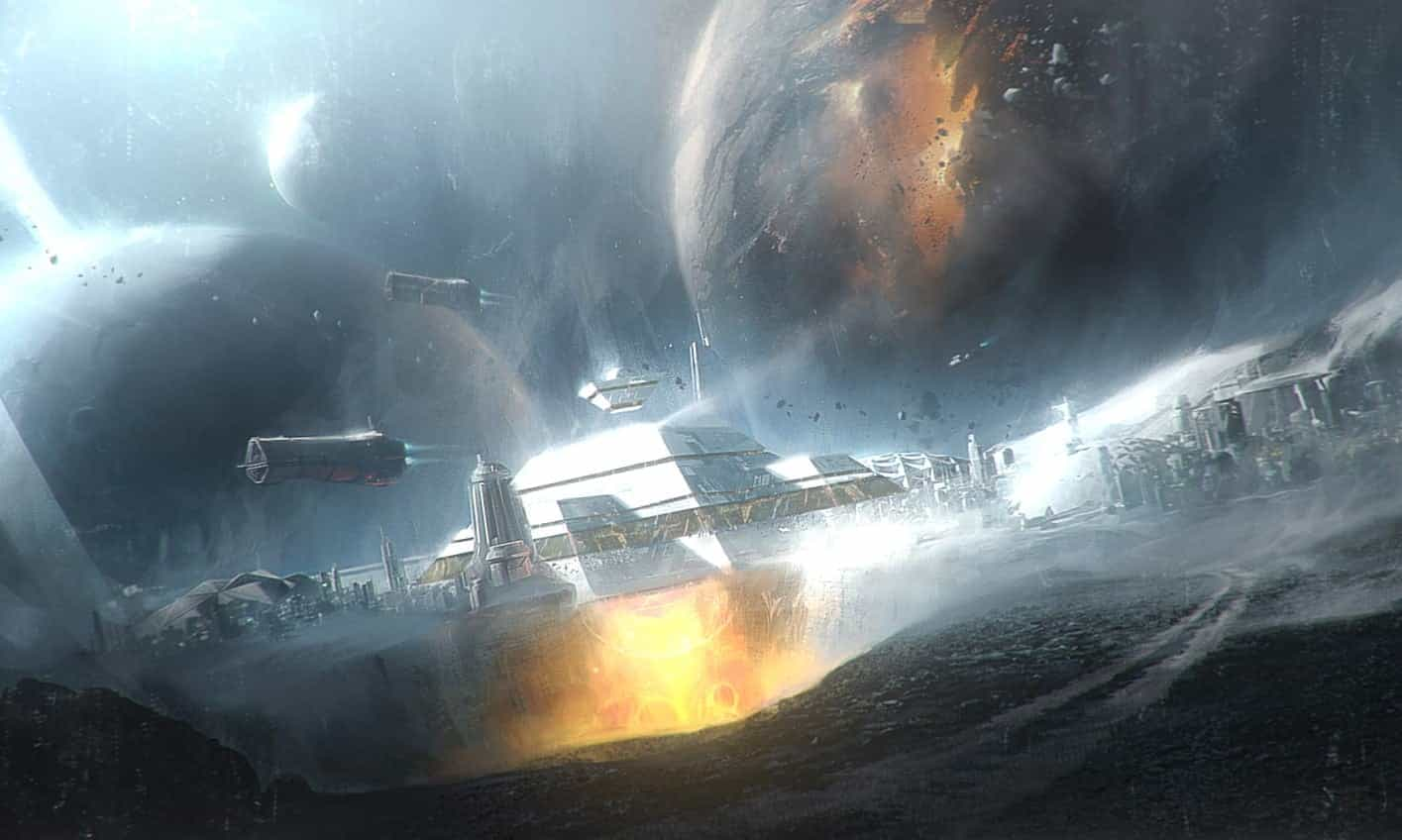
Do you know those frustrating moments in a game where you spot a far-off land or planet and wish you could also explore there? With Star Atlas, every distant planet that you can see can be reached. There is no skybox and no limit to where users can travel. That is, of course, if you have a powerful enough ship, enough crew and fuel to get there, which won’t be easy.
Players will be able to resolve conflicts amicably via political or economic means, avoiding conflict through debating, planning, governing and collaborating if they choose, and if you’ve ever wanted to play God, here’s your chance. Players can spend their time just building, destroying and creating things, or become a scientist and make discoveries. There is literally something for everyone in this game.
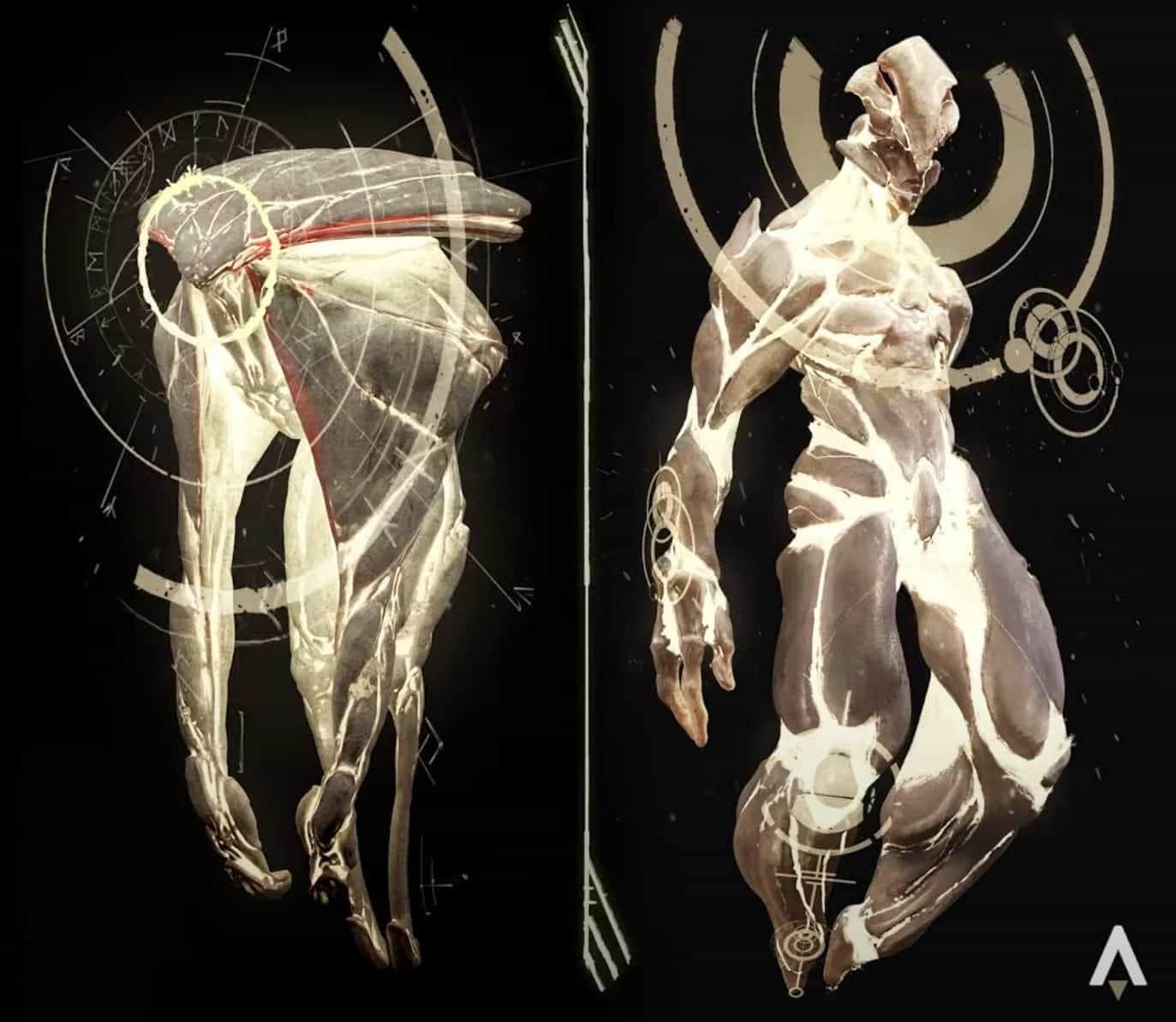
Any players who manage to own a star will be able to build a Dyson sphere, which will allow for the creation of a jump point that will enable independent systems to access immediate travel, cutting down on travel time and providing a significant boost for their economic trading lanes.
All Work and No Play…
The opportunities to monetize and profit within this metaverse are vast and limitless for users looking to turn to the metaverse to earn an income. There are obvious ways to make money, such as building, developing, mining and farming resources and NFT sales. The Star Atlas team are even creating the equivalent of a stock exchange within the game where players will be able to construct trading decks and trading platforms where other players can execute certain trading activities. The universe will have a full-blown economy complete with peer-to-peer transactions for purchases.
Players will be able to create and run businesses, social hangout areas, taverns, restaurants, movie theatres, concert halls, music festivals, fuelling stations, etc., all player-owned and operated, truly providing users with the potential to earn an impactful income within the game. So if you’ve ever wanted to run a gas station or arcade in outer space, here’s your chance.
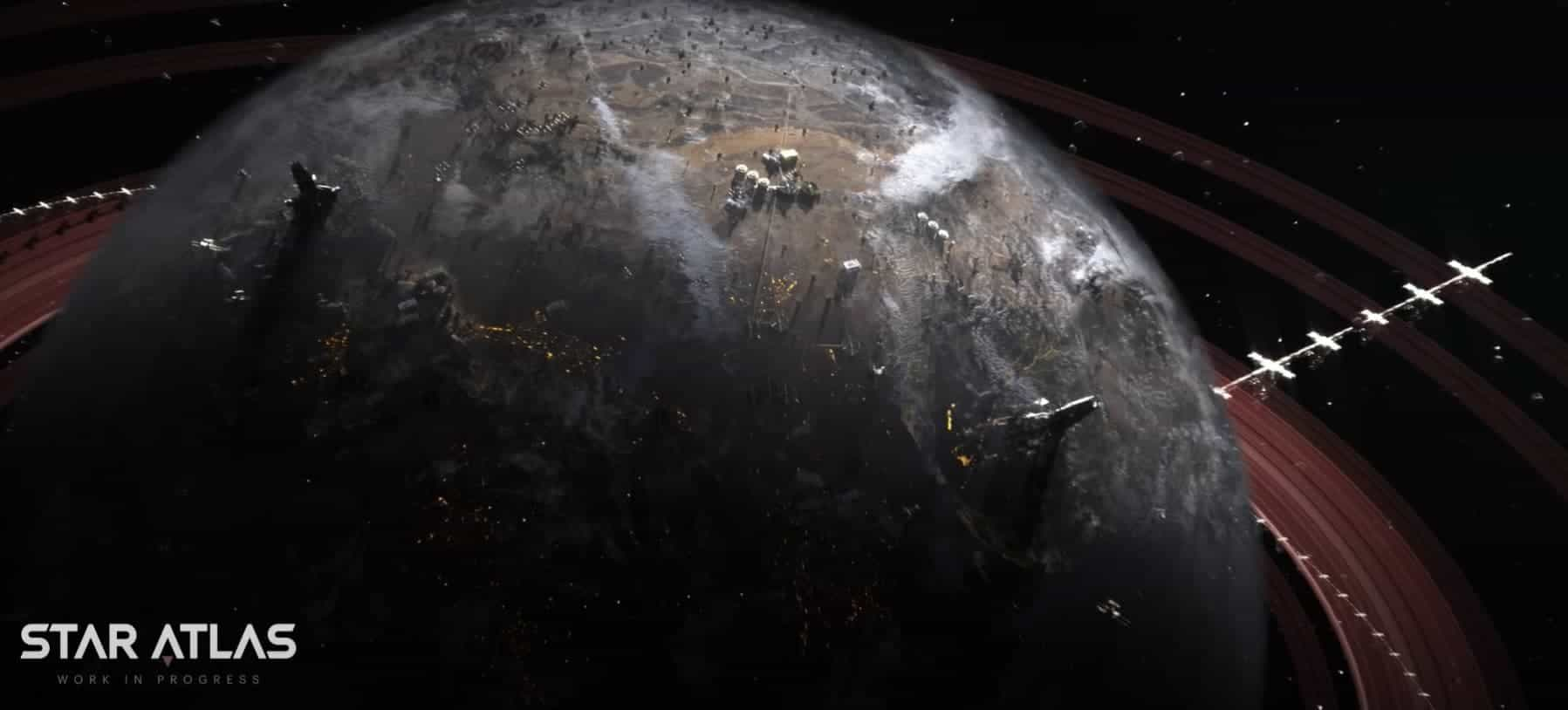
An exciting aspect of the gameplay is that mining and farming will contribute to the universal economy in a way where mined and farmed components will enter the supply chain, and through the refinement of the materials and aggregation of them, players will be able to create and mint their own NFTs based on blueprints that will be created, discovered, and released over time.
Some guilds are dedicated to nothing but the farming and mining sectors, as many players will likely be interested in mass manufacturing NFTs in the future. The opportunities of this game span far beyond simple “gaming,” attracting entrepreneurs and business-minded metaverse enthusiasts looking to make a profit.
Ships
Ships will likely be the first purchase that players will need to make as they will be the primary transport around the metaverse. As mentioned, ships will be owned by the players and have real-world monetary value as they are NFTs, along with all their modifications and upgrades.
There are way too many different types of ships to cover in this article; The Star Atlas site has an article you can dig into to learn about all the different types of Star Atlas Ships you can pick up.
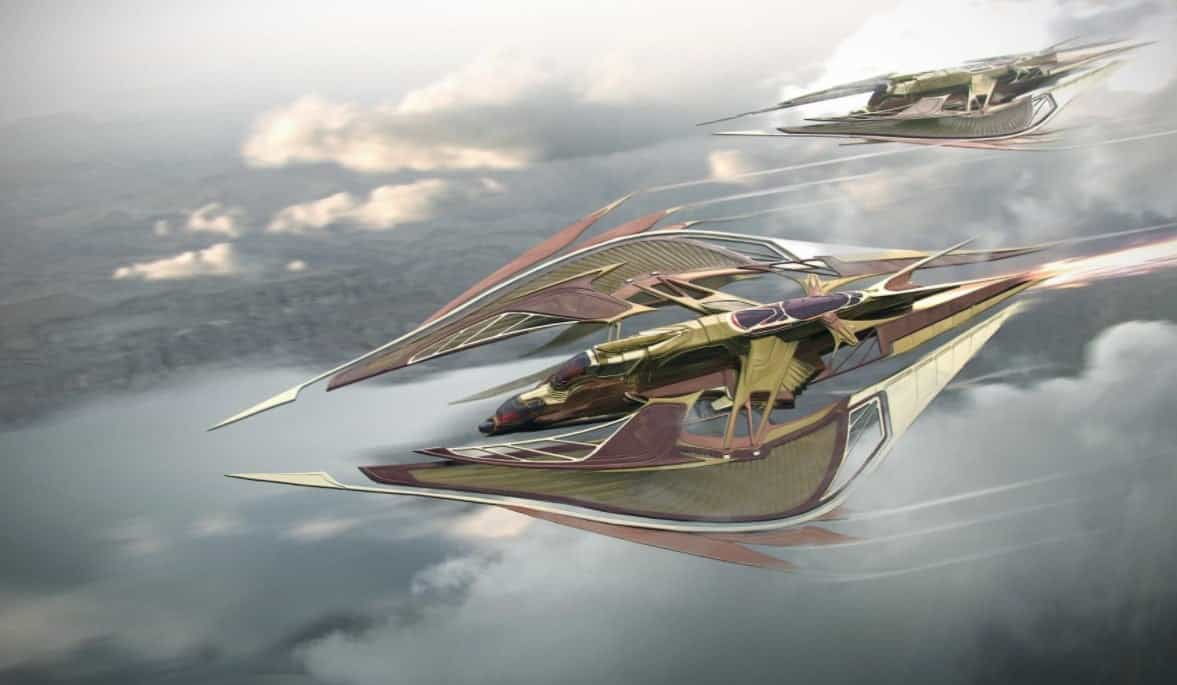
The TL;DR is that there will be different ships for different purposes. There are over a hundred different types of ships of all price ranges, with some even ranging in the hundreds of thousands to millions of dollars. The majority of the ships are going to fall under the following categories:
- Fighter ships
- Racer ships
- Multi-Role ships
- Data Runner ships
- Bomber ships
- Freight Ships
- Bounty Hunter ships
- Refuel/Repair ships
A clever aspect of the game is that the crew members' experience of each ship can enhance the features and stats of that ship, and ships can be kitted out for different roles. The game gets pretty specific with features that players will need to take into consideration, such as the University decks of ships. Crew members who trained together at the same University or on a different ship will add additional buffs when placed as part of the same crew. Matching crews correctly will provide additional buffs, while mismatching them can be detrimental to the ship's performance.
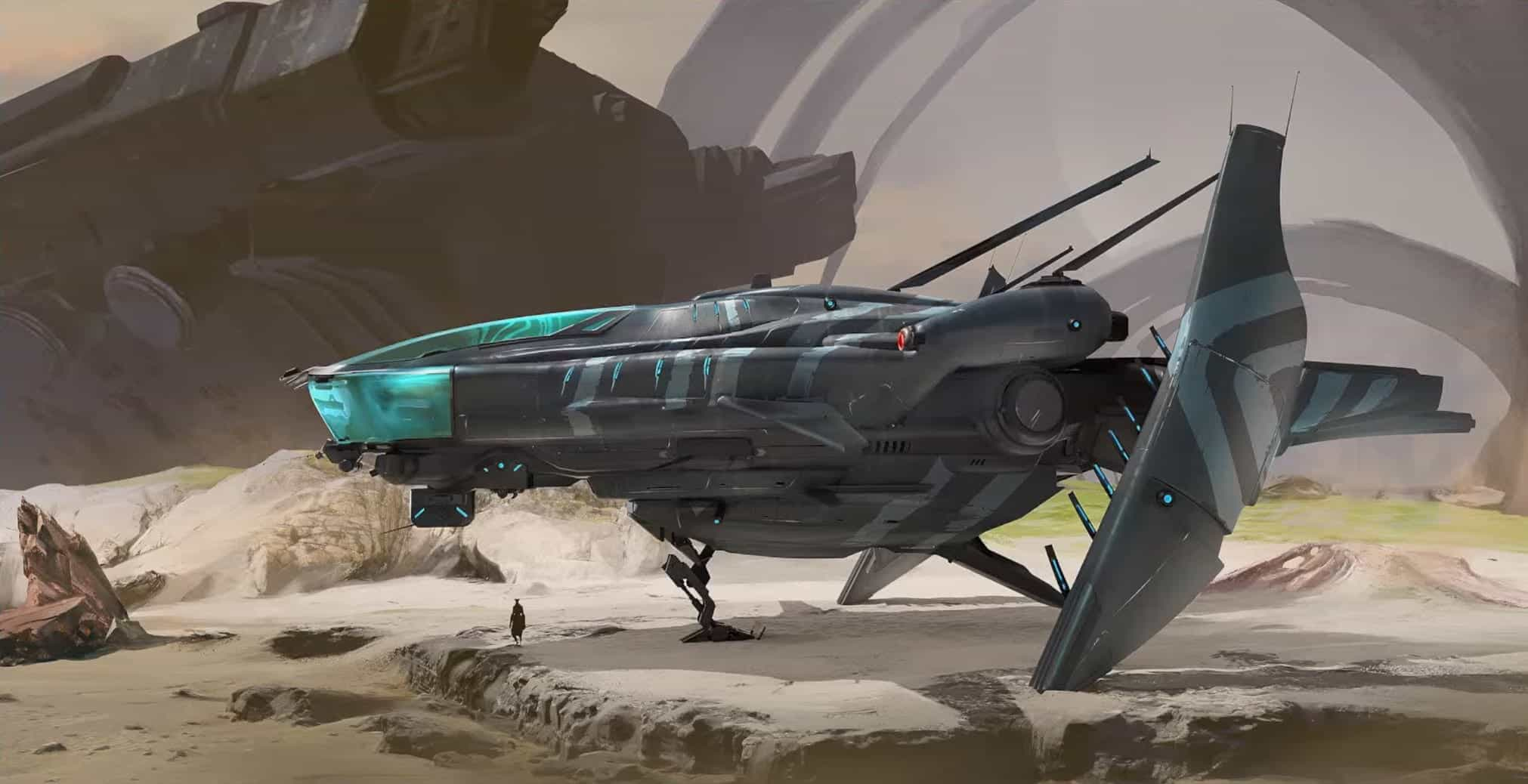
These ships will play a central part in everything from transport to strategy, and the type of ships should be carefully chosen depending on each player’s goals within the game. Ships are already being actively bought and sold on NFT marketplaces, and some ships are simply being held and staked, earning impressive APYs. I dug up a blog where you can learn more about how to stake Star Atlas ships.
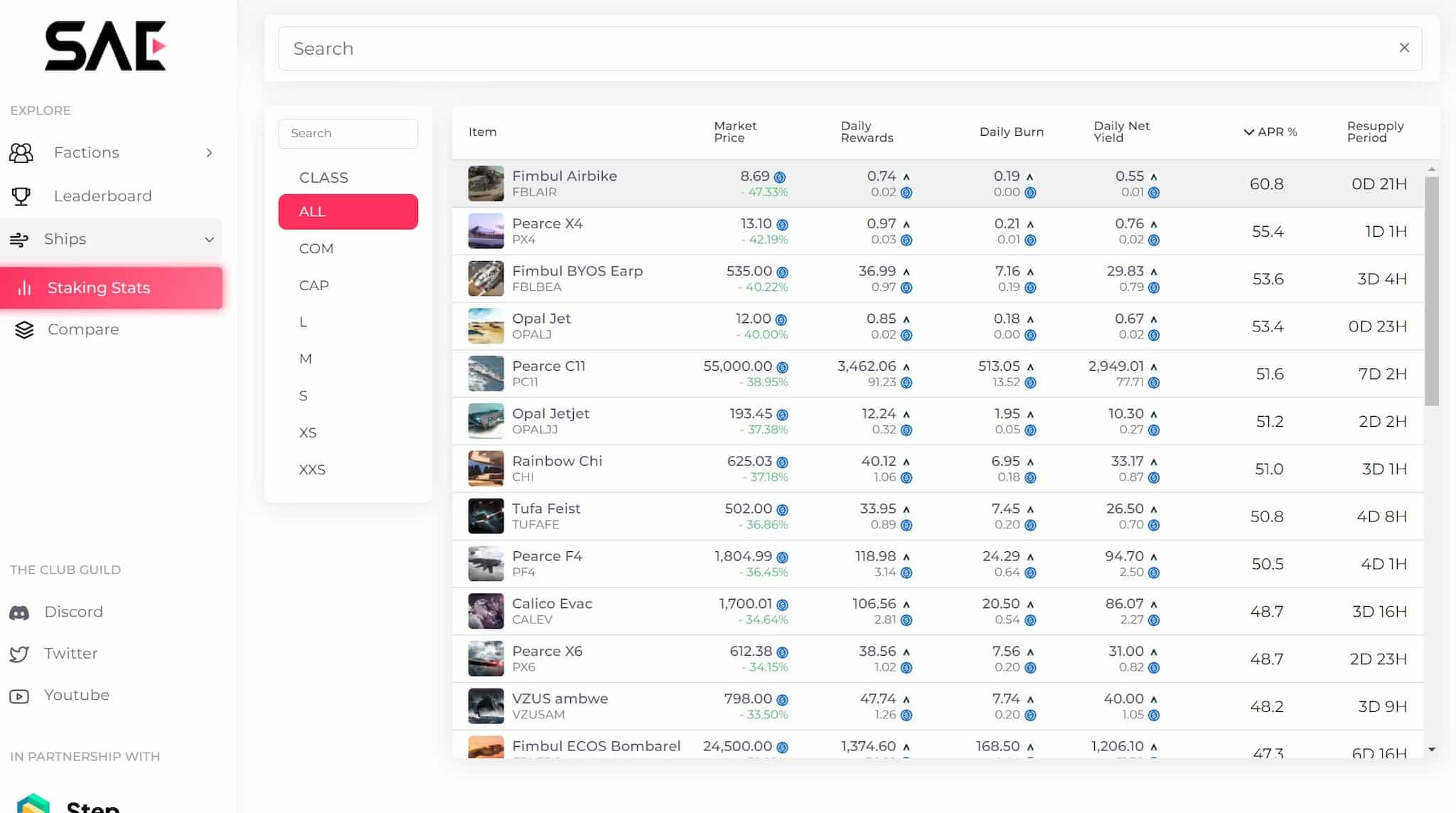
Star Atlas Mining
Not a lot is known yet about how mining will work, and mining equipment is not yet available to purchase. There is speculation that claims on mining land will work in an auction style, and the winner of the auction will pay for the section of land with the ATLAS token and the mining equipment needed. Miners in the “danger zone” will need to ensure they defend their mine as well as opposing players may try and take it by force.
There are currently 3 different structures known that are needed for mining setups. Those are:
Power Plants- Owners must first build a power plant to create the energy needed to power the mining drill and other mining structures.
Mining Drill- Constructing the mining drill will begin the automatic process of extracting materials from the land. Auto-sleds will load the materials, ready to transport them to the nearest chosen space station.
Space Station- Space Stations will come standard with a trading deck needed to access the universal marketplace.
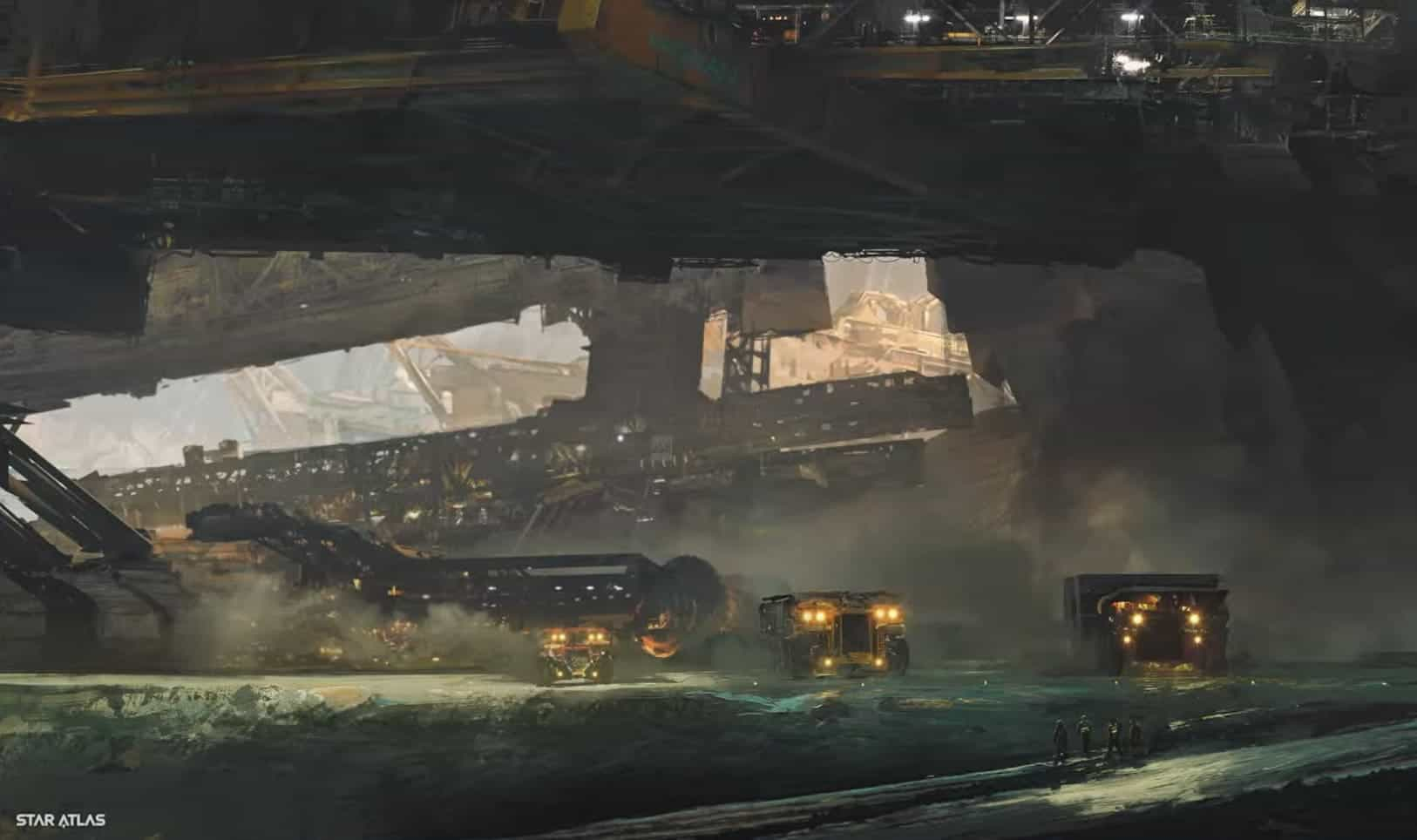
Mining will be a critical pillar that supports the Star Atlas economy. Players will need to invest ATLAS for the necessary infrastructure, crew, and demand auctions. All resources mined will be NFTs, and these can be crafted to create better NFTs. As miners progress, they will gain mining experience, which will unlock increased quality and speed of resource gathering and provide discounts on labour and maintenance costs.
Space Station Construction in Star Atlas
Space Stations will have adjacent mining installations associated with them, and each station will be able to be constructed with different decks. Each deck will enhance the functionality of the space station and unlock features that will allow players to engage with that specific station in different ways. The following decks will be available:
- Commerce for storage and trading
- Shipyard for manufacturing, repairing, refuelling and configuring
- Refinery for refining raw ore
- Hanger for ship storage
- Retail for crafting and selling components
- University for training and recruiting crew
- Cargo for storing materials
- Defensive for building defence turrets
Space stations with commerce decks will need to connect to the universal marketplace to sell items. And if all this spaceship and space station talk has you missing the good old days, the Star Atlas team has you covered:
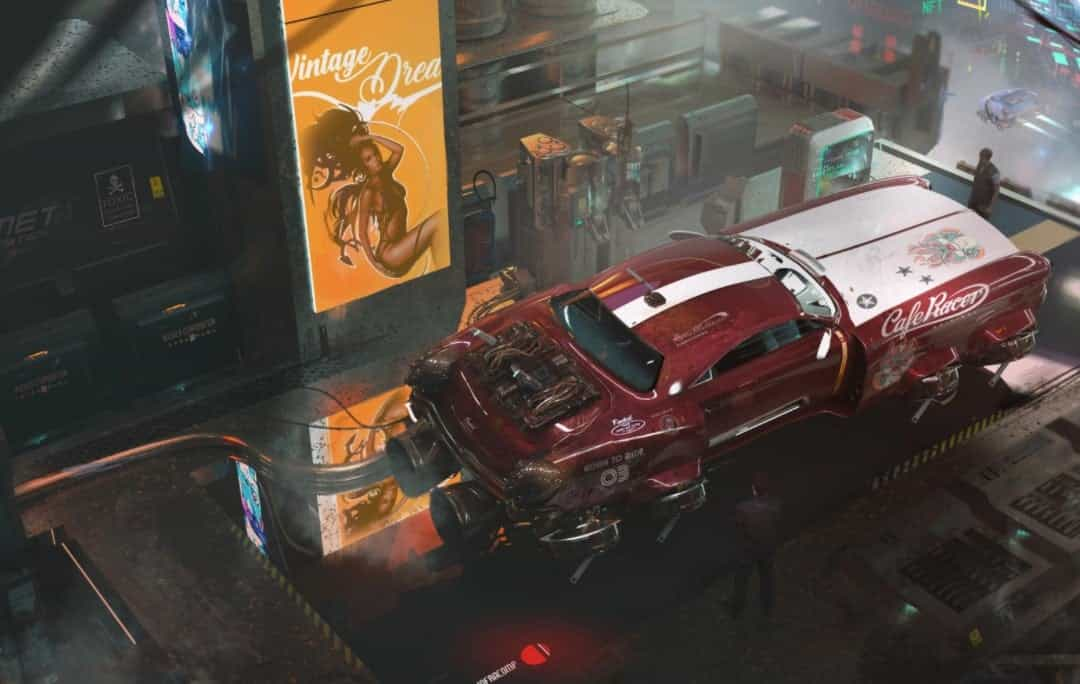
DeFi Included in Star Atlas
The goal of the in-game economy is for the earnings and proceeds to be primarily reinvested back into the game, creating a self-sustaining economic ecosystem much like the one on our planet. Players who want to thrive in the game will need to focus on business operations, costs, and business processes, much like in real life.
As players can earn with any of the in-game assets that they own, there will be a responsibility on the player to manage the efficiency of their operations, meaning that a portion of their revenue will need to be reinvested into maintaining operational efficiency and performing tasks like refuelling, repairing damage, feeding the crew, advertising and so on. On land, players will need to manage expenses and pay for land tax and repairing mining and farming equipment.
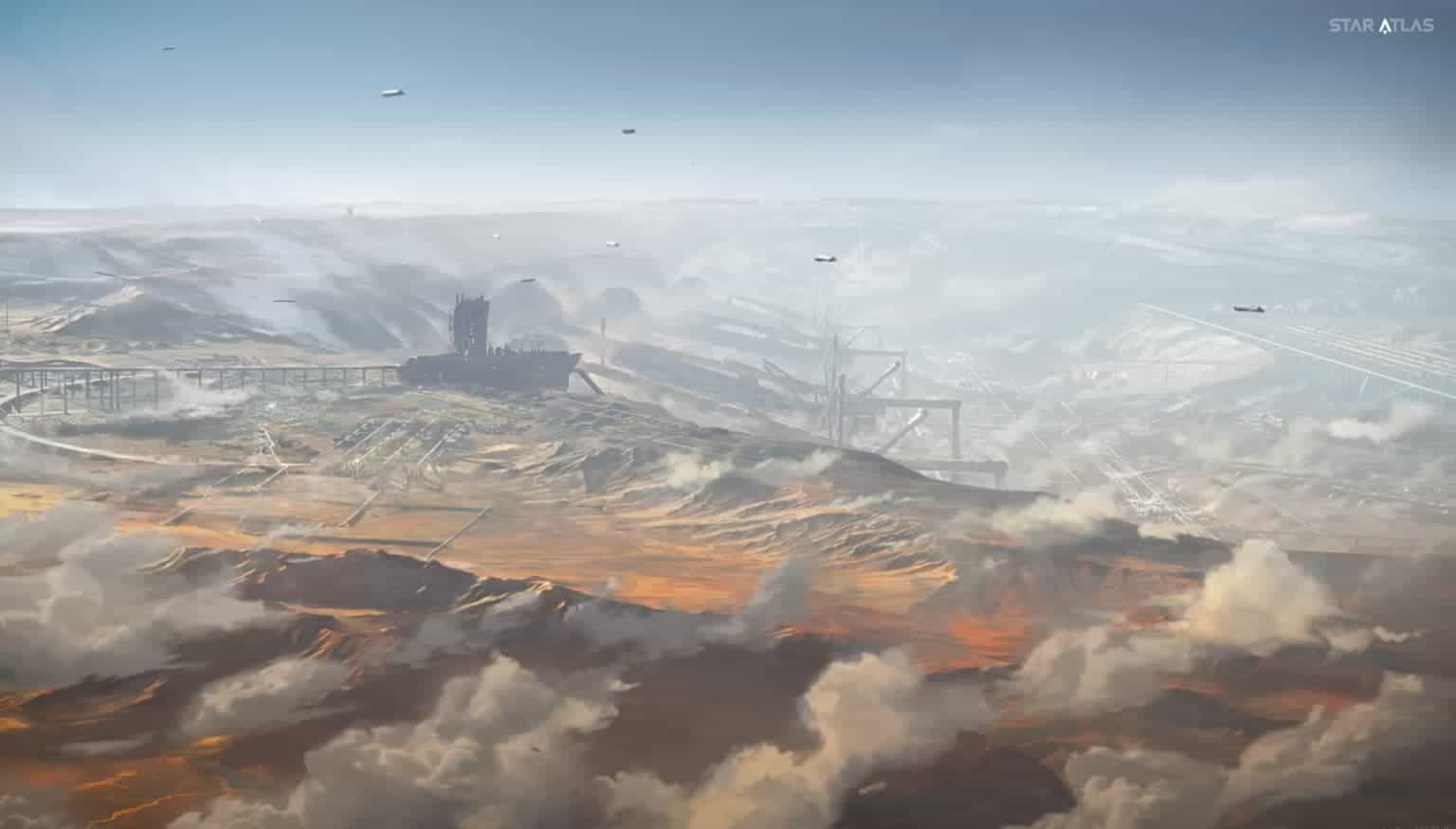 Image via Star Atlas
Image via Star Atlas
Alright, well, that sounds similar to how things work in the real world, but what are players meant to do with their profit? Sell their Atlas tokens and put the cash in the bank where it will get deflated away or earn 0.01% interest?
Please…. By the time this game is in full swing, the Star Atlas team and I are hoping that much of the world will have woken up to the pointlessness, greed, and corruption of the traditional banking system and will have largely migrated to DeFi. DeFi platforms and mechanics will be integrated directly into the metaverse, so those sweet earnings from successful conquests, the selling of NFTs, or the profits from your space refuelling station can be placed in your DeFi platform of choice or your "bank" in the metaverse. These DeFi products are where players will be able to earn an attractive yield on earnings, take out loans, and access all the other features that DeFi has to offer.
And in case you are wondering where all the tax and operational money will go, all that Atlas cash will flow directly into the Star Atlas treasury, which will be controlled by the DAO, who will continue to fuel the development and expansion of the future of the Star Atlas metaverse.
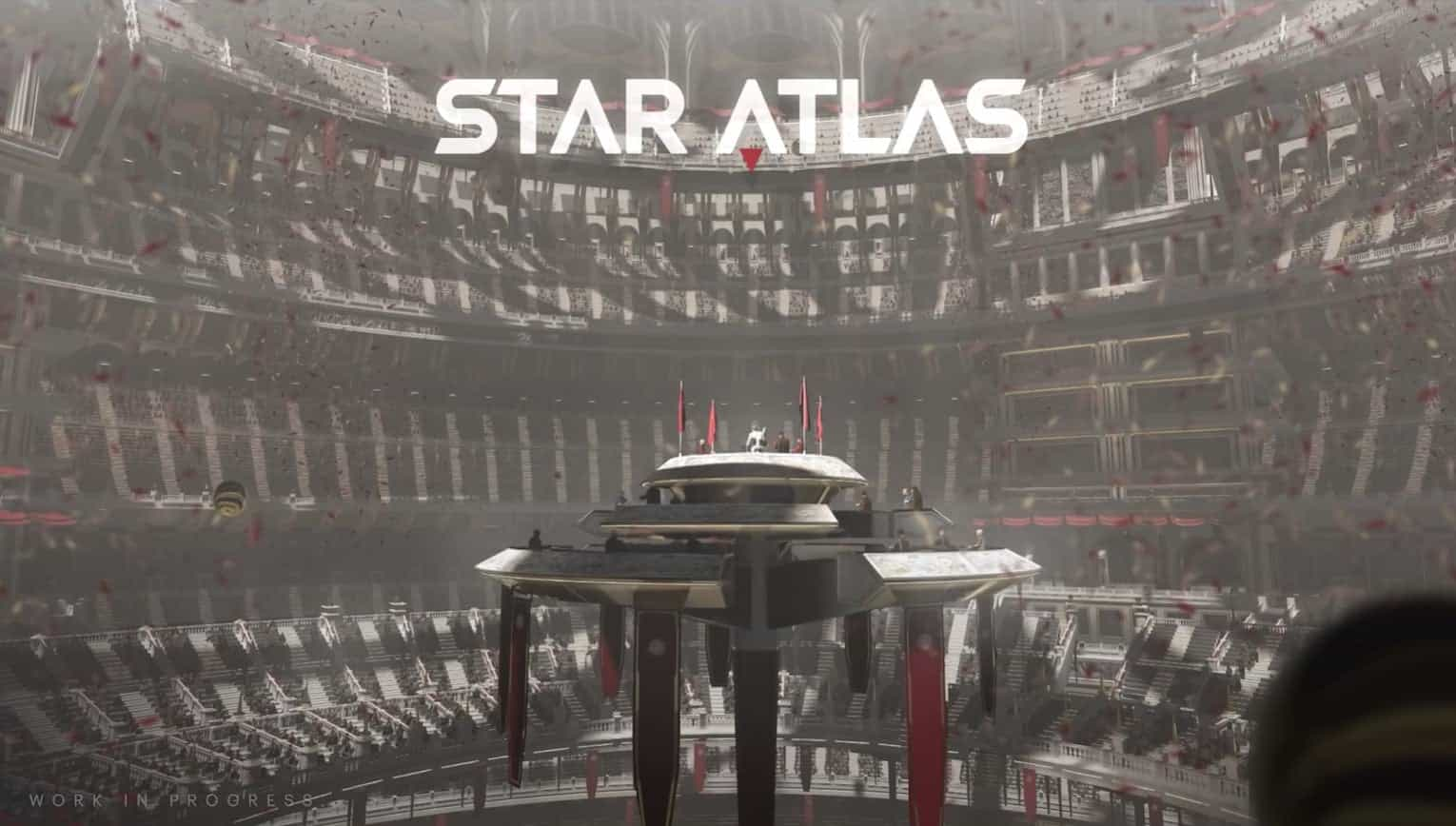
Tokenomics and Economics
The tokenomics/economics of this game are pretty advanced, more advanced than I believe have ever existed in any game or virtual world. Much like economics in real life, many of us are unlikely to fully understand or care about the intricacies. That is okay, though, just as I don’t need to understand the entire economic landscape of my country to use my dollar to buy candy, players aren’t going to need to have an economics degree to enjoy the game.
Michael Wagner, the CEO and co-founder for Star Atlas, designed the in-game economy and tokenomics, had a former career in traditional finance and received his CFA as a certified financial analyst and worked as a portfolio manager for many years. He used his experience and working knowledge of traditional finance to contribute to building the economic landscape in the Star Atlas universe.
The metaverse is going to have two in-game tokens. One that will be used as a medium of exchange between players, for making in-game purchases, for use in the DEX, and used as the primary reward token called the Atlas (ATLAS) token. The other one will be the Star Atlas DAO token (POLIS) which will be used for governance. Holders of the POLIS token who stake it will have governing rights on the platform, allowing them to make and vote on proposals that will dictate the future of the Star Atlas universe.
The ATLAS token had an initial sale offering price of $0.00138, then a public launch price of $0.068 and quickly shot up well over 1,500%, reaching an all-time high of just over $0.25, then came crashing back down as early investors took profit. The ATLAS token has seen struggling price action along with the rest of the crypto market amidst uncertain macroeconomic times.
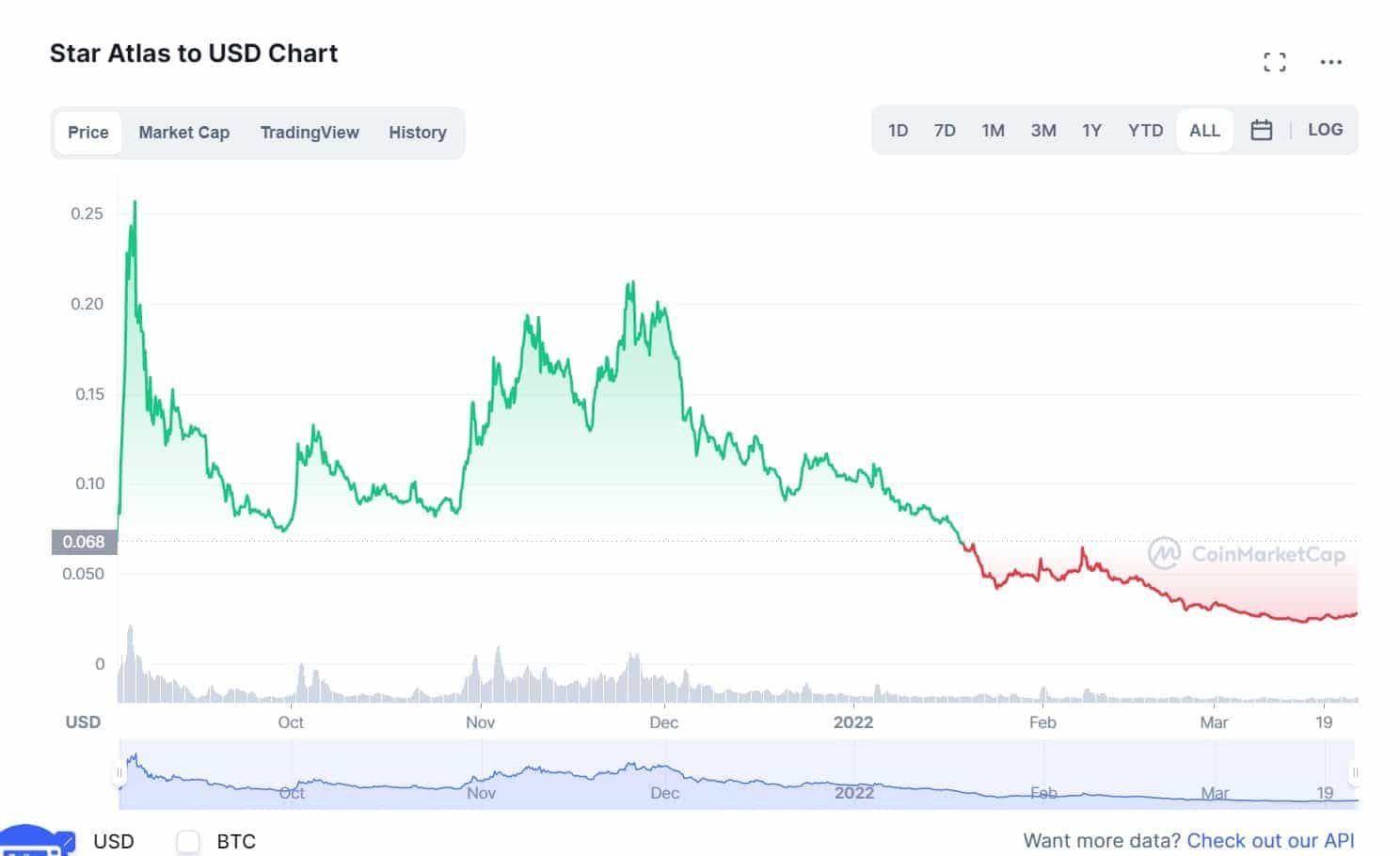
Many investors and players consider the ATLAS token to be a good long-term hold and are accumulating at low prices as it is anticipated that price appreciation will steadily increase over the years as the game gets closer to launch and as more people learn about the game and players load up their bags to start making purchases.
The ATLAS token was created with inflationary features to match and scale with the inflation of the in-game economy. This will ensure that the currency and price of items remain reasonable for new players over time.
The minting and burning of ATLAS will be based on the user growth and adoption of the platform. Therefore, the supply and price will be kept on a level to maintain reasonable in-game asset pricing internally and optimize the entry level for new users while simultaneously allowing for price appreciation.
Here is a look at the ATLAS distribution curve:
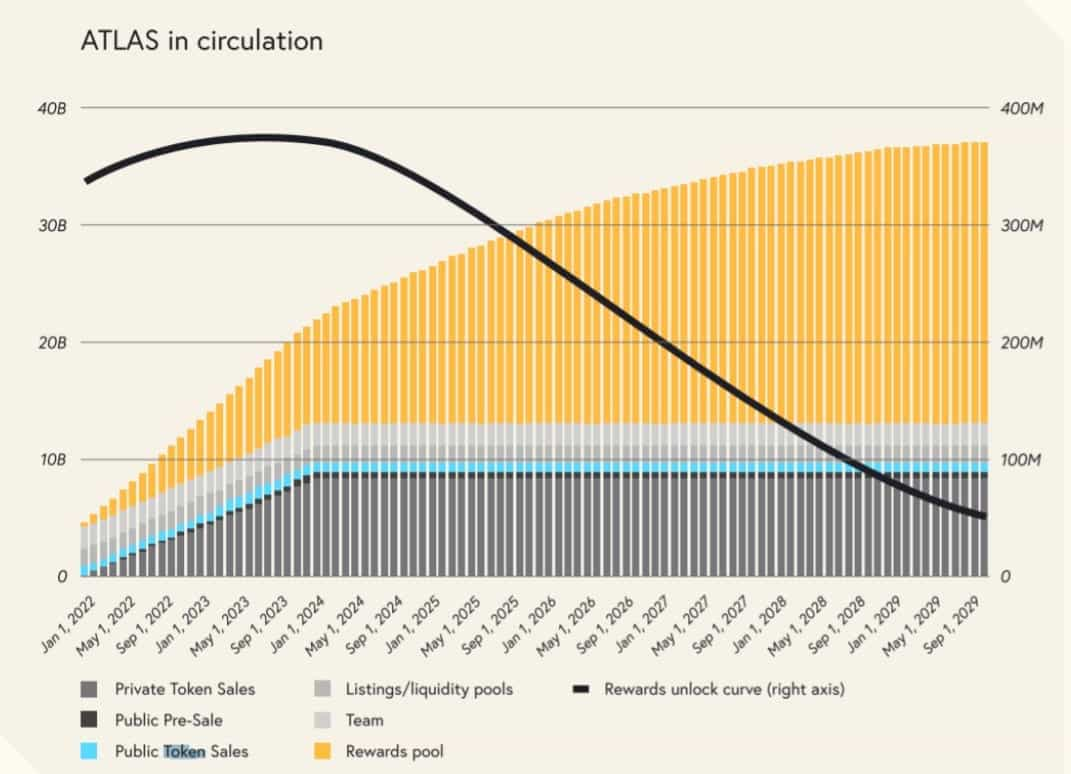
The total supply of Atlas will be thirty-six billion, it will take eight years for the supply to be fully diluted, and the team allocation is only five per cent. Interestingly, the team has zero stake in the undistributed token supply, something uncommon in the crypto space. I have to respect the team for that, as it shows that this project is clearly more than just a cash grab for the creators. The distribution of the tokens and issuance was carefully planned out and are committed to things like mining stations, resource gathering etc. Here is the breakdown of the Atlas token issuance:
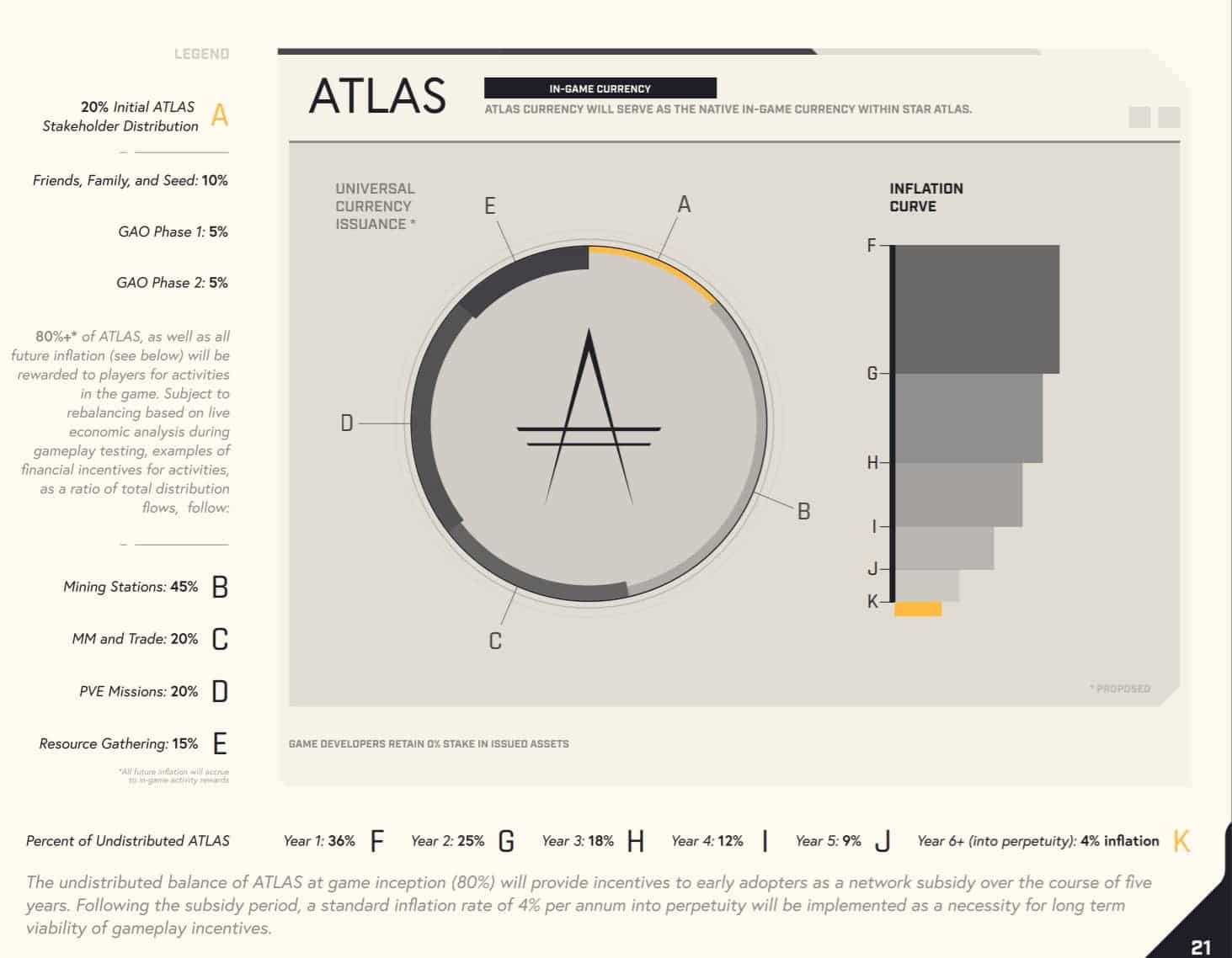
The monetary policy of ATLAS will be rolled out in three distinct phases. I won't cover that in the interest of keeping this article within reasonable length, but you can find information about it in this handy Star Atlas Guide.
The Star Atlas DAO token aims to be a long-term store of value and will serve as the governance token throughout the entire metaverse. The POLIS token represents a financial stake in the game, provides holders with voting power, and the DAO will control the treasury. The Polis token will have a total fixed supply of three hundred and sixty million, which is one per cent of the total number of Atlas tokens. Those who participate in governance proposals will also earn portions of the returns in ATLAS tokens to incentivize participation. Users will be able to earn the POLIS tokens in the following ways:
- Primary Issuance: The Star Atlas team may directly sell POLIS tokens to potential governors
- Secondary Markets: Can be bought and sold on secondary markets but come with a finite variety of lockup/vesting schedules
- In-game Rewards: Completing certain missions in-game
- Metagame Rewards
- Governance Participation: Staking in the DAO and being active
- Meta-economics Rewards: Liquidity provision on AMMs and other DeFi entities
I have only barely covered the in-game economics, and I wasn't kidding when I said it was complex as it involves resource management, building, fighting, activities, zones, governance, etc. I can't get into it all here, but I urge you to explore the 38-page Star Atlas economics paper if you want to know more about it.
The Star Atlas Tokens can be purchased on Bitget, OkCoin, Kraken, Raydium.io or Orca.so
Star Atlas Potential versus other Metaverses?
So, what makes Star Atlas better than the play-to-earn games and metaverses currently in existence?
This all comes down to the game's tech, storyline, innovation, and functionality. As much as people love Ethereum, we are all aware of the painful downsides and limitations it has. Star Atlas is built on the powerful, nearly light-speed Solana network as its backbone, providing nearly server-less operation. Though one can't help but wonder, with the issues Solana has faced regarding downtime, it waits to be seen if Star Atlas may eventually migrate to many Ethereum scaling solutions now in full swing.
One of the most exciting announcements is that this is powered by Unreal Engine 5's Nanite gaming engine, which will give Star Atlas incredible, in-world cinematic quality gameplay and graphics, something not yet seen in the crypto gaming sphere. In all honesty, the graphics seen so far in blockchain games, in my opinion, have been well…. 💩
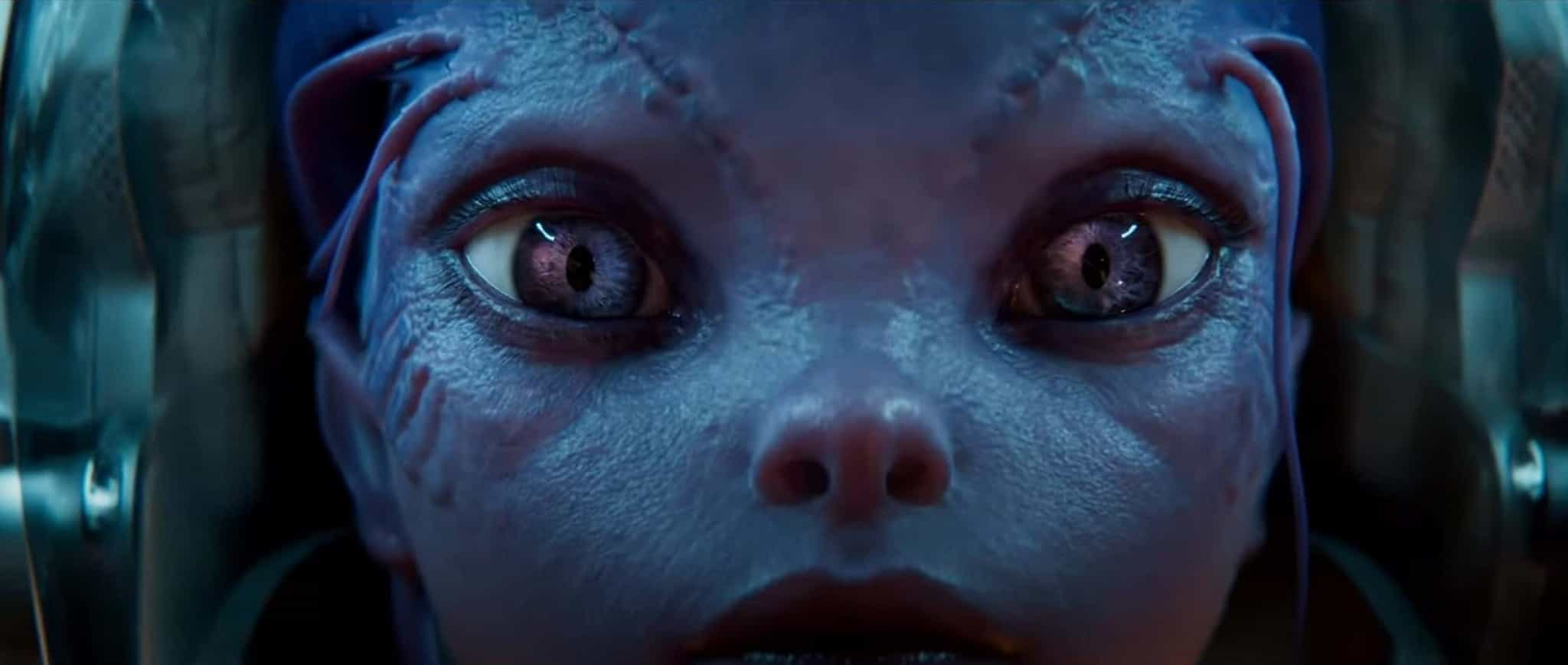
Battling cartoon-like 2D creatures and duelling card games has not provided gameplay exciting enough to attract serious gamers into the blockchain gaming space, but Star Atlas may be the lynchpin that brings gamers who appreciate a higher quality of gameplay, graphics and storyline.
Hearing that this game is being deployed on what is arguably the most advanced real-time 3D creation tool we have to date is sure to impress even the most hard-core gamers. Unreal 5 has been the powerhouse gaming engine behind many triple-A titles, and they have been swamped since the explosion in metaverse popularity. So if you ever see hyper-realistic metaverse graphics, there is a good chance Unreal 5 is the gaming engine behind it.
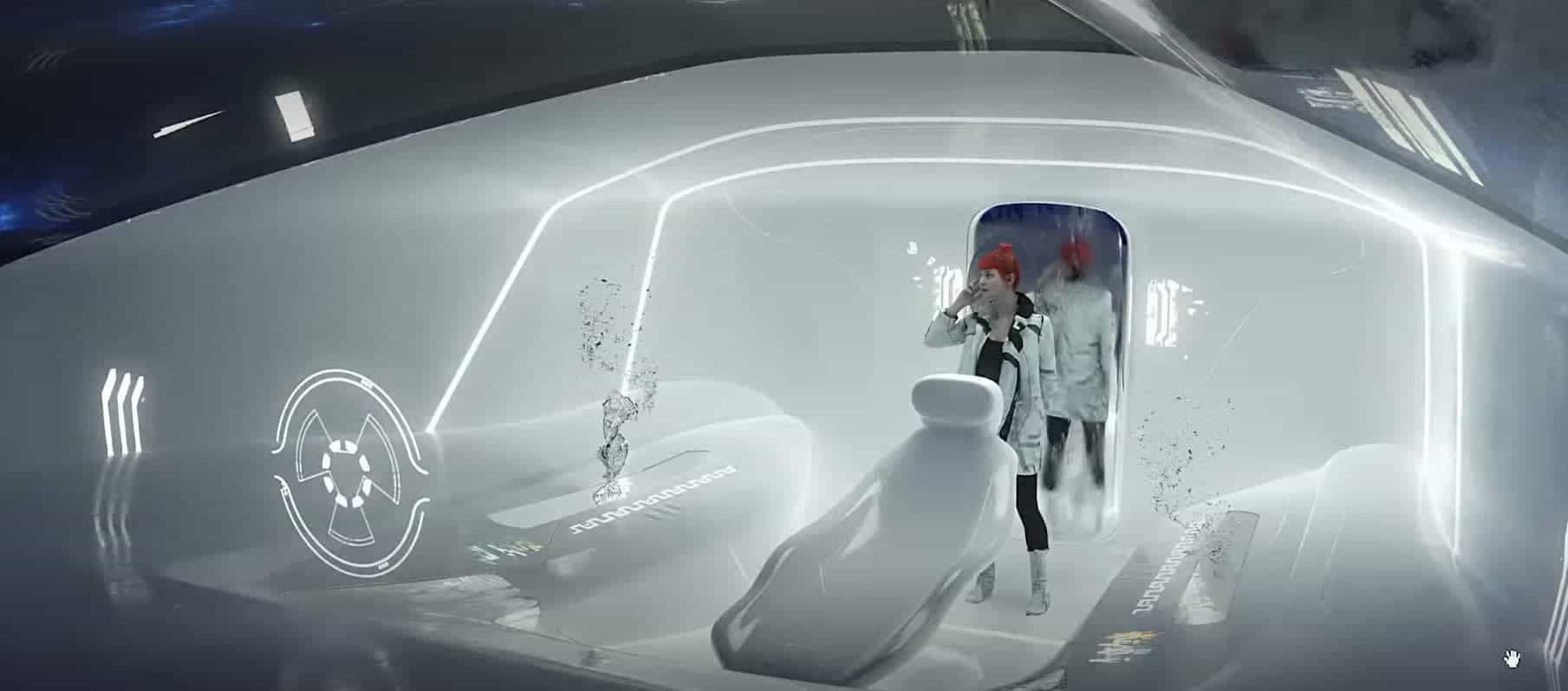
The Star Atlas team has the majority governing rights over the metaverse for the next few years to ensure that development timelines and requirements are met, but they have designed the DAO potential in a way that the metaverse will be able to expand and evolve long after the original creators pass on from the project. Just as the Solana ecosystem will evolve, so will the Star Atlas metaverse.
The eventual goal is for the metaverse to be completely self-fuelling and self-sufficient to ensure its longevity as gamers, builders, developers, governors, entrepreneurs, and innovators continually contribute to the evolution of the space.
This is speculation not only on my part but after listening to multiple interviews with the CEO that there really is no limit on how high the ceiling for this metaverse can go. Because Star Atlas is being built using open blockchain technology on top of Solana, there is no cap to how many developers can create limitless projects in the Solana ecosystem that may integrate with Star Atlas.
Think things like DeFi, insurance protocols where players may be able to insure their spaceships and equipment, decentralized lending which will allow players to take out loans to purchase equipment, gaming guilds will play a role where guilds can rent out equipment and sponsor players, a whole universe of retail and commerce, event hosting, and other possibilities that we haven’t even considered yet.
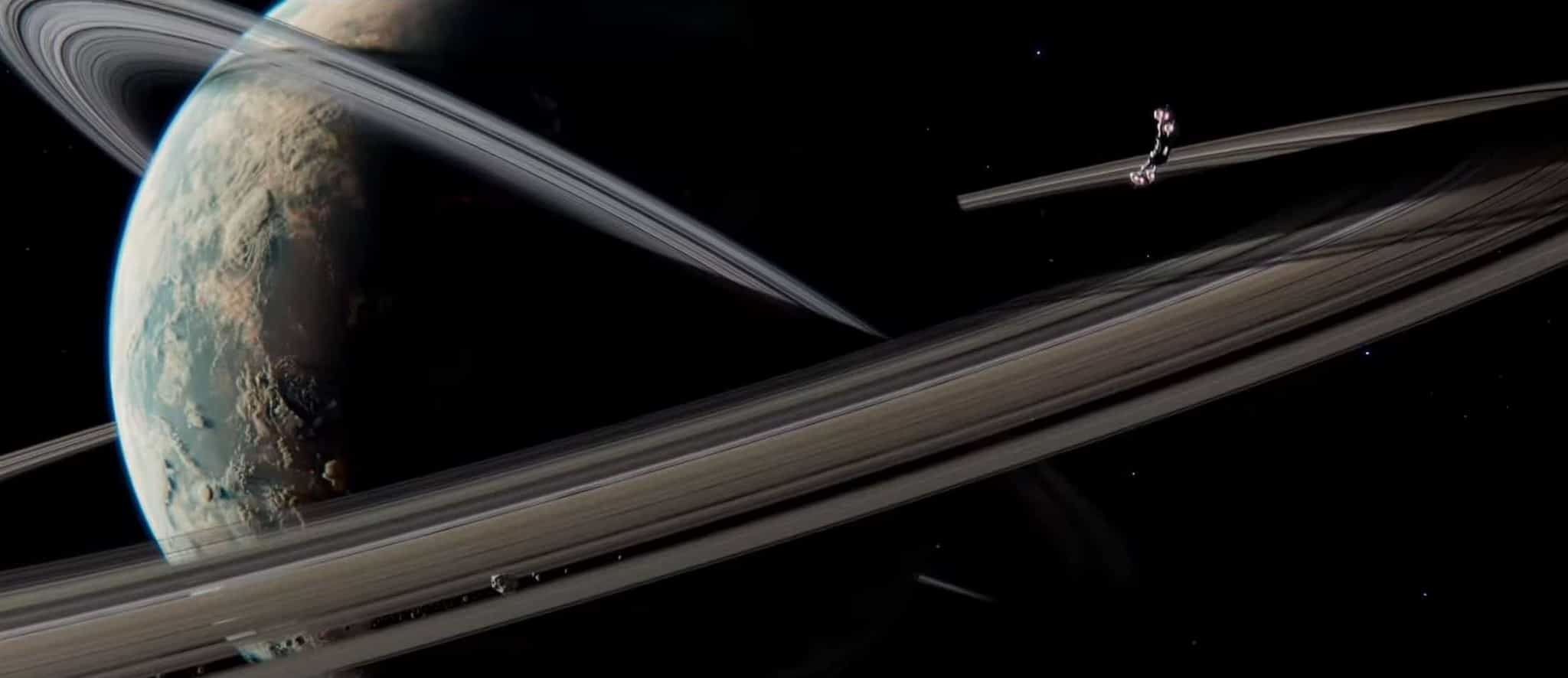
The team has a vision to eventually release APIs and software developer kits (SDKs) to help encourage future entrepreneurs and developers to create and build within the Star Atlas metaverse, and just as the internet evolves with each of its content creators, the Star Atlas metaverse will evolve much in the same way. Giving the players and community the keys to the kingdom, so to speak, and allowing anyone to contribute user-generated content within the game is a great way to let players get involved at a much deeper level and genuinely contribute to the immersive world that they not only exist within but helped create.
Here is a look at how Star Atlas has ranked itself amongst their largest competitors:
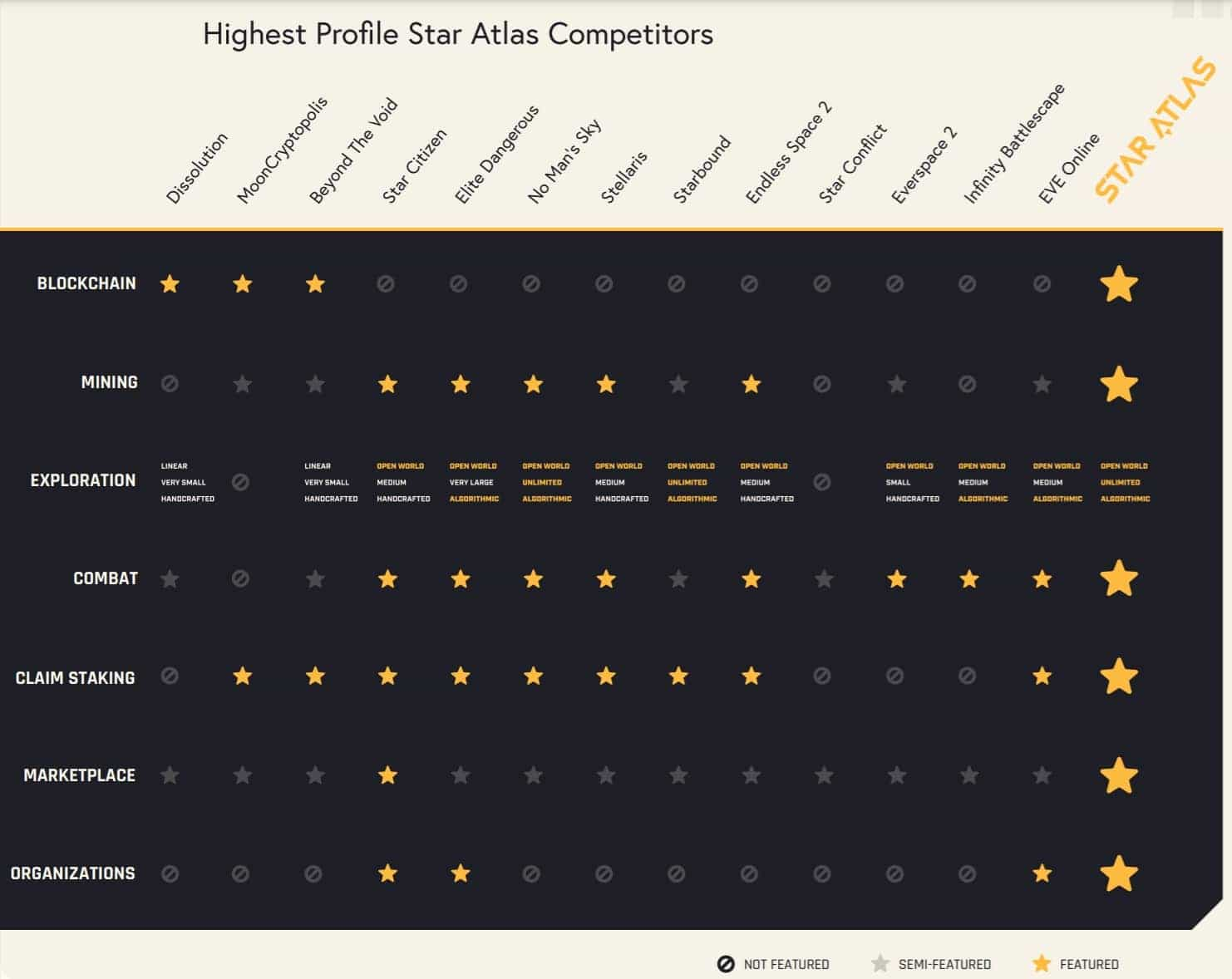
When comparing a metaverse like Star Atlas to company-controlled metaverses like Meta (Facebook), the contrast is night and day in terms of permission, centralization and ownership. Facebook’s Meta will likely follow the route of being a closed, or at best, semi-open permissioned system, meaning they will hold the cards close to their chest and ultimately retain complete control over their metaverse and all the data and content created and stored within that realm.
Just as they do with their Facebook and Instagram platforms now, the Facebook (Meta) corporation is the authoritarian body controlling everything, collecting user data, selling your data, etc. Nobody is likely going to “own” anything within Facebook’s Meta. Facebook will ultimately have complete control akin to Thanos in the Avengers once he acquired all the infinity gems.

Star Atlas will be released as an open permissionless system, staying true to the ethos of what crypto and blockchain technology were created for. Eventually, Star Atlas aims to be completely decentralized and permissionless, and therefore completely censorship resistant where users ultimately retain control over their digital selves, data, content, and items, a true oasis of a metaverse compared to the authoritative dictatorial style metaverse monstrosity that Facebook is looking to create. I think I'll pass on playing in a metaverse where "the Zuck" is judge, jury, executioner and God-like being where he sees and controls all. *shivers*
Mini-Game Launch
As gamers anxiously await the game's full launch, the Star Atlas developers released a mini-game to tide users over. An in-browser web app mini version of the game was launched called "Score." The gameplay features ship commissions on remote expeditions and gives players the ability to take their spaceship NFTs, list them in a faction and manage resources associated with the ships, things like fuel, food, ammunition, make repairs etc. so users can get familiar with the ship mechanics and start earning already.
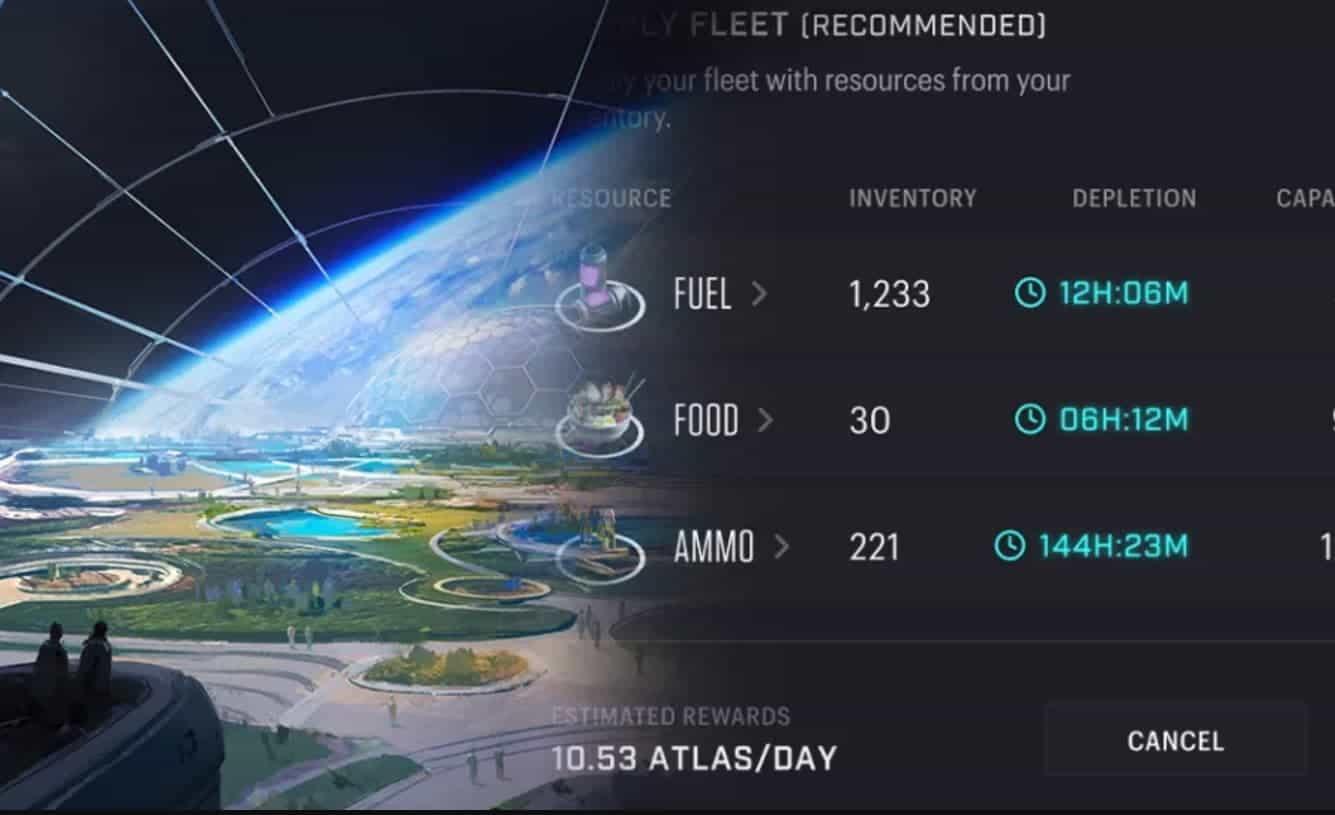
Players can buy ships, start forming their fleet, and even earn ATLAS tokens from the minigame.
R2 Update: Showroom, Dogfights, Racing, and Jetpacks!
In 2023, Star Atlas released the much-anticipated R2 Update, adding further gameplay, functionality, and careers to the Star Atlas universe. Not only did the roster of flyable ships get expanded, but players were thrilled to finally be able to race their ships around and compete for the global racing leaderboard.
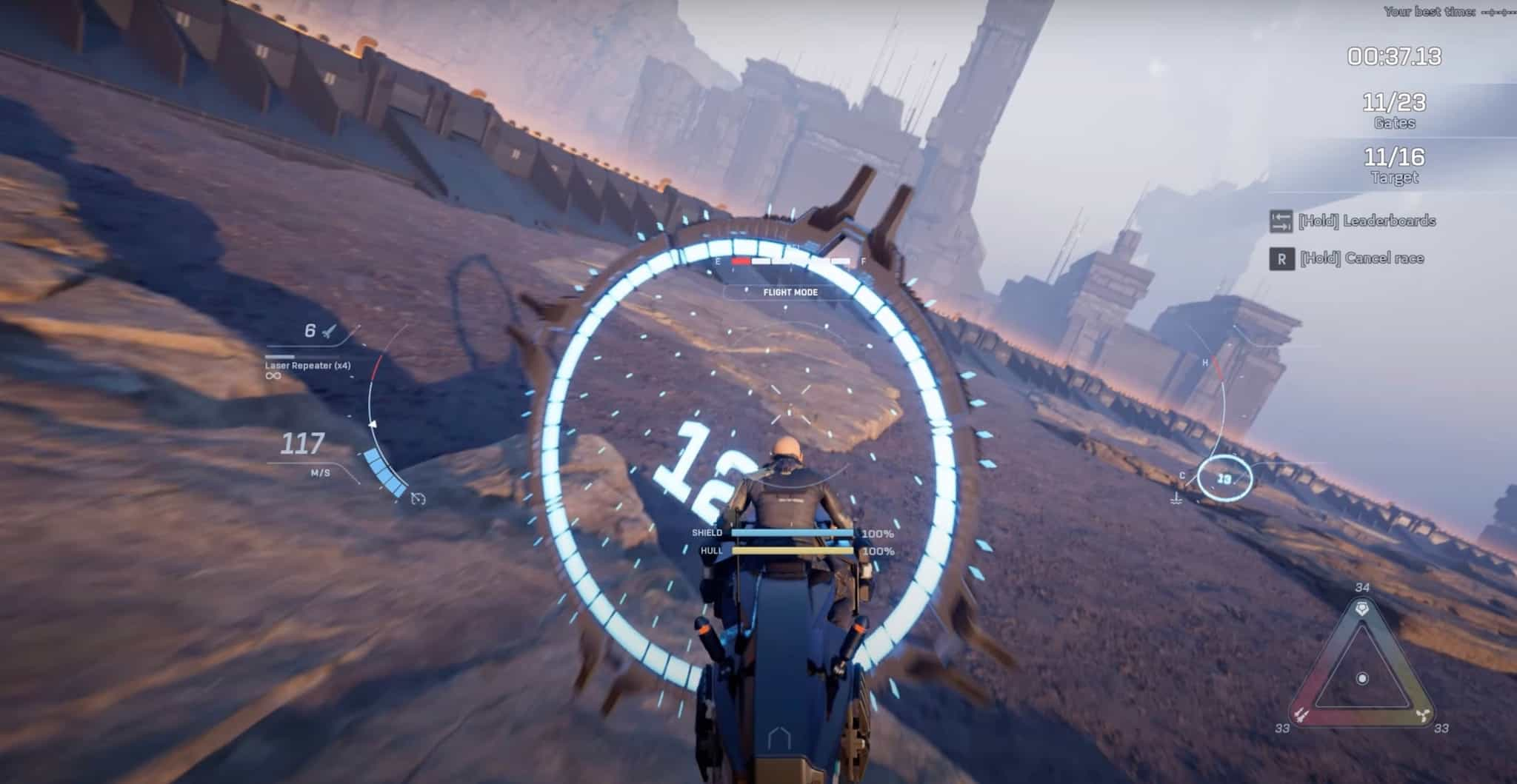
Once you get tired of racing, the dogfight mode was also a fantastic addition for those wanting to test their fighter pilot Ace skills against waves of enemy spacecraft. Like the racing mode, the dogfight mode also has a leaderboard where players can compete to see how many waves they can survive.
When you need a break from the high-adrenaline activities, players can now take a relaxing free-roam flight around the alien worlds with their jetpacks and online multiplayer friends, enjoying the scenery made possible by the Unreal 5 Engine.
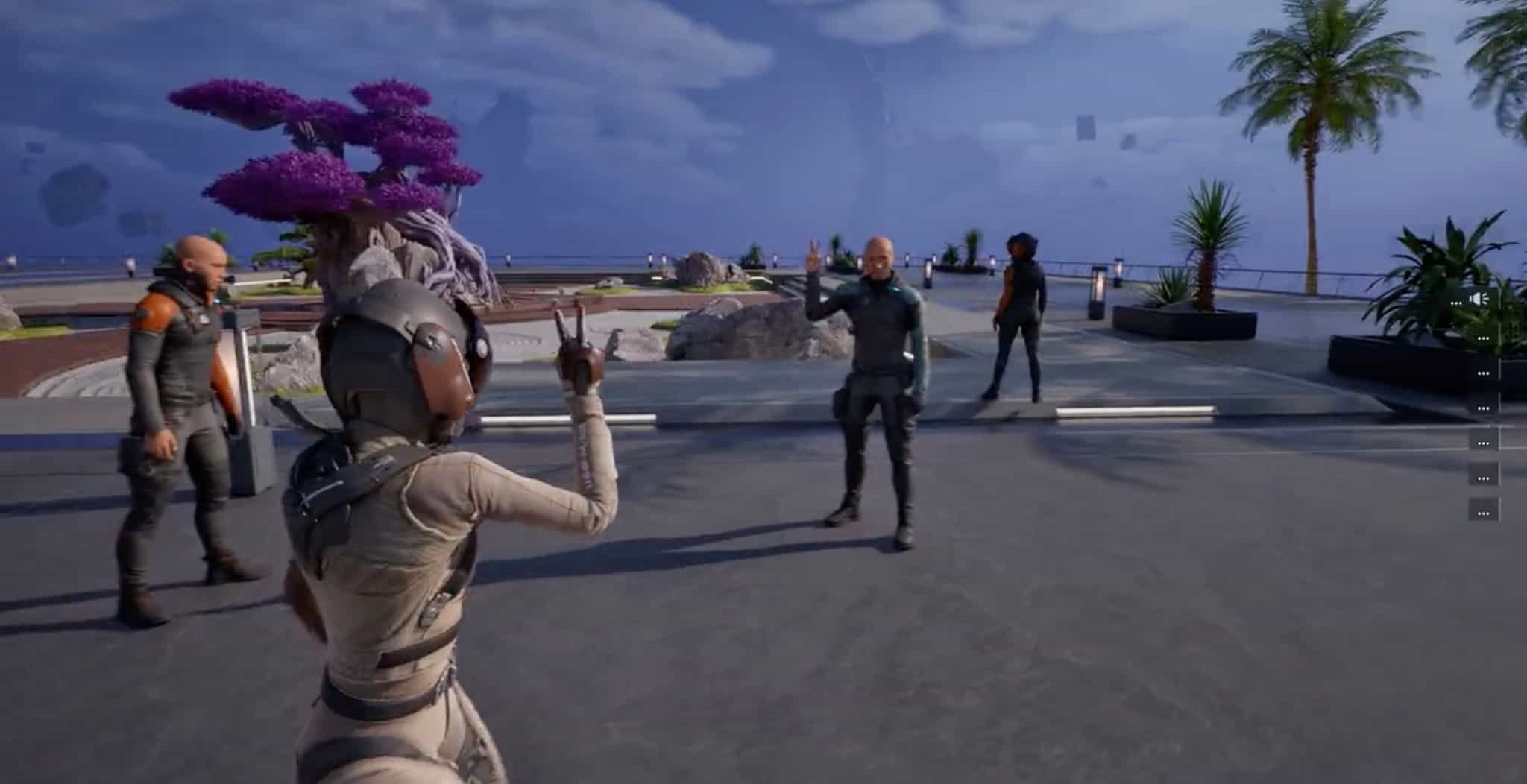
May 2023 also saw the release of the second playable mission for players in the Star Atlas metaverse and the first Social Campaign where players can band together and uncover secrets about the Star Atlas universe, making choices that will impact the ecosystem and Decentralized Autonomous Corporations that exist within the universe.
In September 2023, Star Atlas launched Sage Labs, a space exploration game where you can extract resources, craft rare items and compete for over $1.2 million in loot with the Golden Tickets raffle. Seven days after the game's release, the company shared some statistics:
- 5,961 profiles created
- Over 3.4 million Solana transactions
- 3% daily average of Solana transactions
- 20,000 fleets created
Team Behind Star Atlas
Star Atlas is brought to us by the team that built Multichain Ventures, a triple-A title game and blockchain-driven virtual metaverse gaming development company. The Multichain Ventures team has been involved in blockchain since 2013 and possesses four years of expertise in building decentralized applications.
This team has worked together closely, helping to develop triple-A titles with big players in the gaming industry such as Electronic Arts, Mythic Entertainment, 3G Studios and 1047 Games, so they have plenty of experience and know what is involved with the creation of amazing games.
Michael Wagner is the CEO and co-founder of Star Atlas. As mentioned, Michael’s former career was in the traditional finance industry, and he holds a CFA charter as a certified financial analyst. This means he knows how to make money work and isn’t likely to make poor investments or business decisions, which is a good skill and experience for someone creating an entirely new economic system and society in a digital universe.
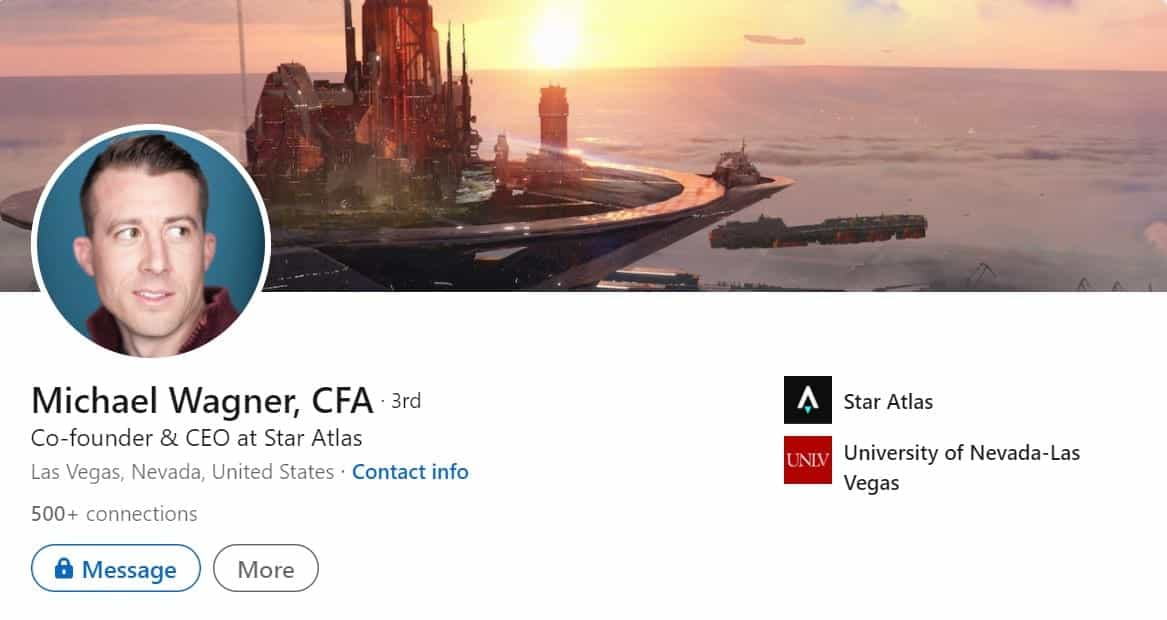
The CFA certification is no small accolade, nor is it easy to achieve. This certification comes with strict ethical guidelines for proper business and investment practices which is one of the reasons that many early investors have the confidence to back Star Atlas. The fact that Michael is a public figure, is very open and transparent in multiple interviews and holds a certification of high calibre has given investors confidence that this project isn’t likely to be a rug pull or flop dead.
It is also interesting to note that Michael is a long-time Bitcoin fan. He got into Bitcoin mining himself in 2013 and has a strong understanding of the technology behind blockchain technology.
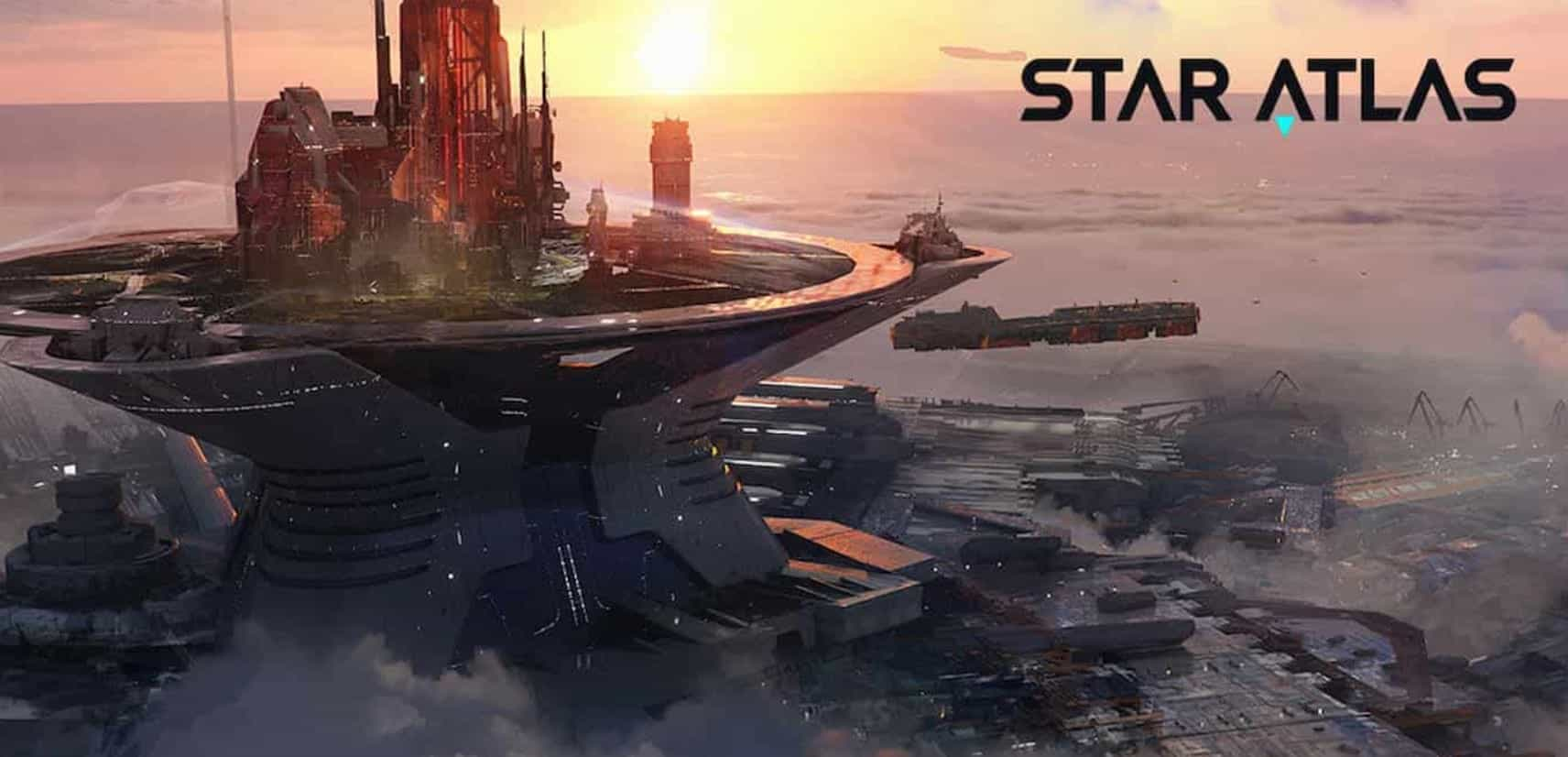
The other two co-founders of Star Atlas are the same co-founders of Multi-Chain ventures, Danny Floyd and Jacob Floyd, who have been working with Michael since 2015.
Danny Floyd is the Chief product officer and the imagination and vision behind much of the gameplay, storyline, in-game mechanics, and development. While Wagner is the brains behind the in-game finance and economics, Danny and his brother Jacob have over 20 years of game development experience building triple-A titles for large game companies, including the 2003 space-themed RPG called Earth Beyond.
While Michael takes much of the spotlight, he has given a large amount the well-deserved credit to the Floyd brothers as creating such an in-depth world, coming up with the intricate gaming mechanics and the look, feel, and design of a game of this magnitude is awe-inspiring.

You can find a full list of the team here.
Long-Term Vision and Roadmap
As discussed in the project whitepaper, the team anticipates that there will be additional universe zones added that will be built on additional blockchains. While Solana will remain the backbone, the ability to expand the metaverse cross-protocol is the multi-chain future that many crypto enthusiasts dream of, which is why projects like Polkadot and Cosmos are so exciting.
Player-created content will also be huge for the Star Atlas metaverse. By rolling out mod kits, developer tools and APIs, there will be no limit to how this metaverse may evolve, as the only limit will be human imagination. The team has a vision of billions of users actively engaging in the Star Atlas metaverse. Imagine having millions of those players building, creating, innovating and inventing new constructs within the game.
With an estimated 1/3 of the world being classified as “gamers” in some sense, it is no wonder that many high-profile investment firms are referring to the metaverse as the next multi-trillion-dollar industry. Star Atlas is hoping to leverage Solana's future scalability to handle billions of users who will interact with the Star Atlas metaverse daily. These users will live their very digital lives in this virtual realm. The team plans to roll the game out in phases, but I was unable to find any official word on a firm launch date other than reading that it won’t be released for several years yet. However, you can keep up to date by keeping an eye on the Star Atlas timeline roadmap.
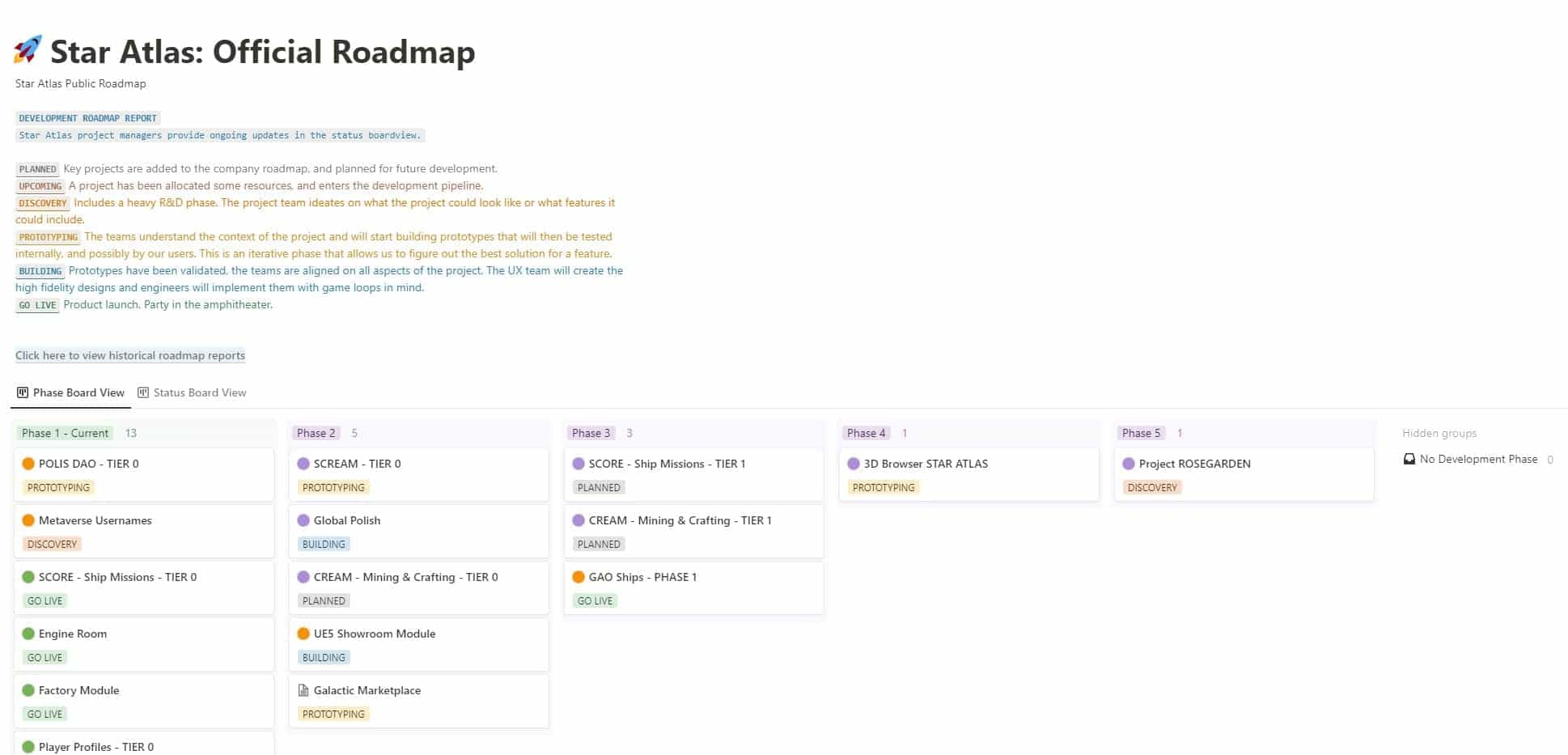
You can find the rest of the roadmap on the Star Atlas Official Roadmap Notion Site.
If you want to stay up to date on all things Star Atlas, I recommend checking out the Intergalactic Herald for weekly news updates and newsletter, covering all things Star Atlas-related.
How Games Like Star Atlas Can Have Real-World Impacts
The game will undoubtedly attract gamers, but it is also likely that people will venture into the Star Atlas metaverse simply to work, find employment, explore entrepreneurial ventures, build enterprises and earn an income.
We have already seen that happen with blockchain games like Axie Infinity, where thousands of players from across the globe quit their jobs as they could earn a higher salary playing the game. Axie Infinity saw accelerated adoption in countries where jobs are scarce, and inflation has ravaged national currencies to the point of near worthlessness. Many families have turned to blockchain games like Axie as a life raft as their sole source of income. Star Atlas will likely attract users for the same purpose but on a much larger scale.
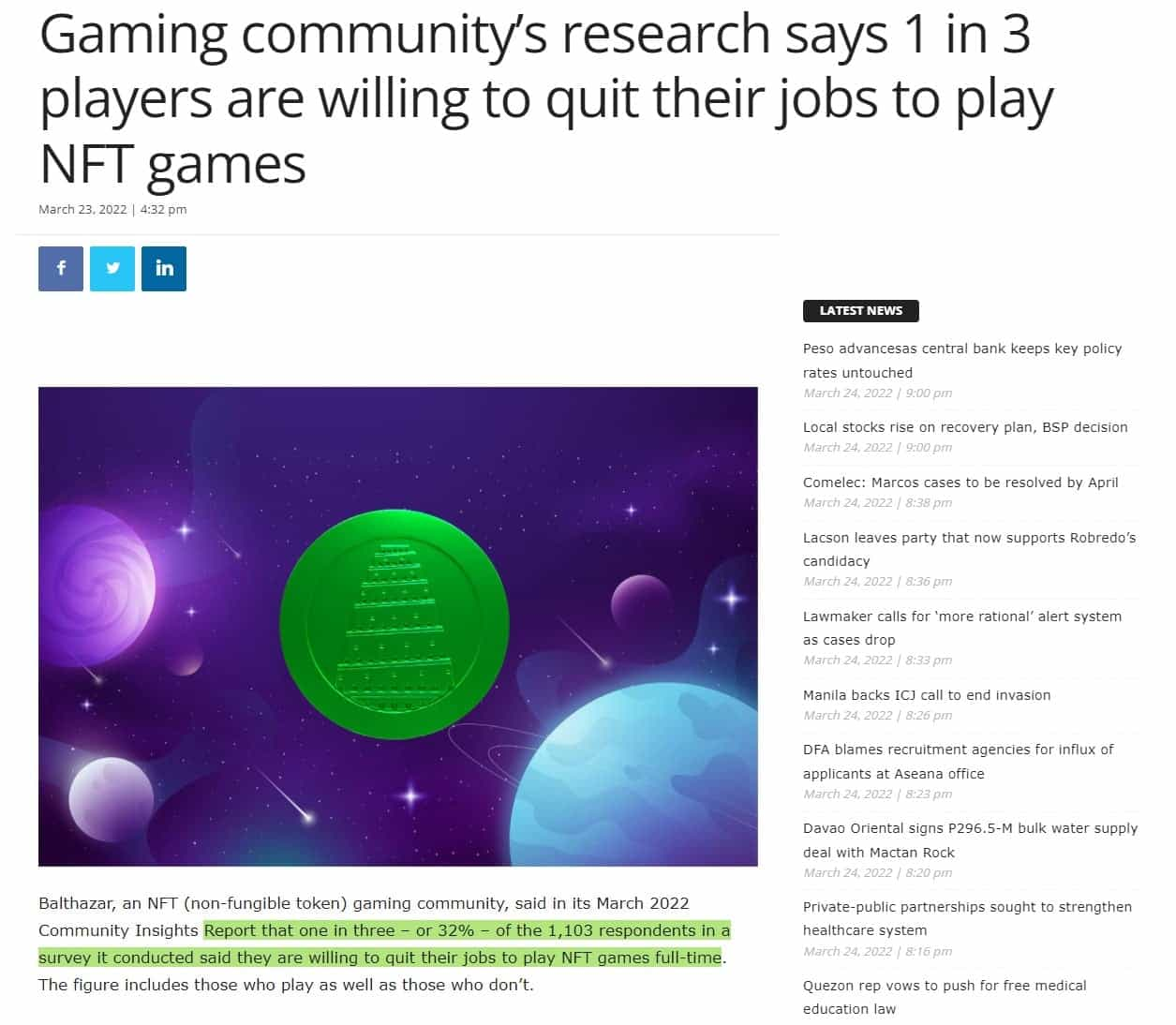
There are already venture capitalist firms invested in Star Atlas, many of whom I’m sure are eager to purchase some of the million-dollar ships once they become available. Businesses will operate within metaverses, and they will need to hire players to run operations in these digital worlds, providing people with equal employment and entrepreneurial opportunities regardless of their physical location on Earth or background. For the first time in human history, the concept of a metaverse has massive potential to do away with the limitations of our physical world, breaking down jurisdictions and borders that often dampen opportunities and oppress the people within certain boundaries.
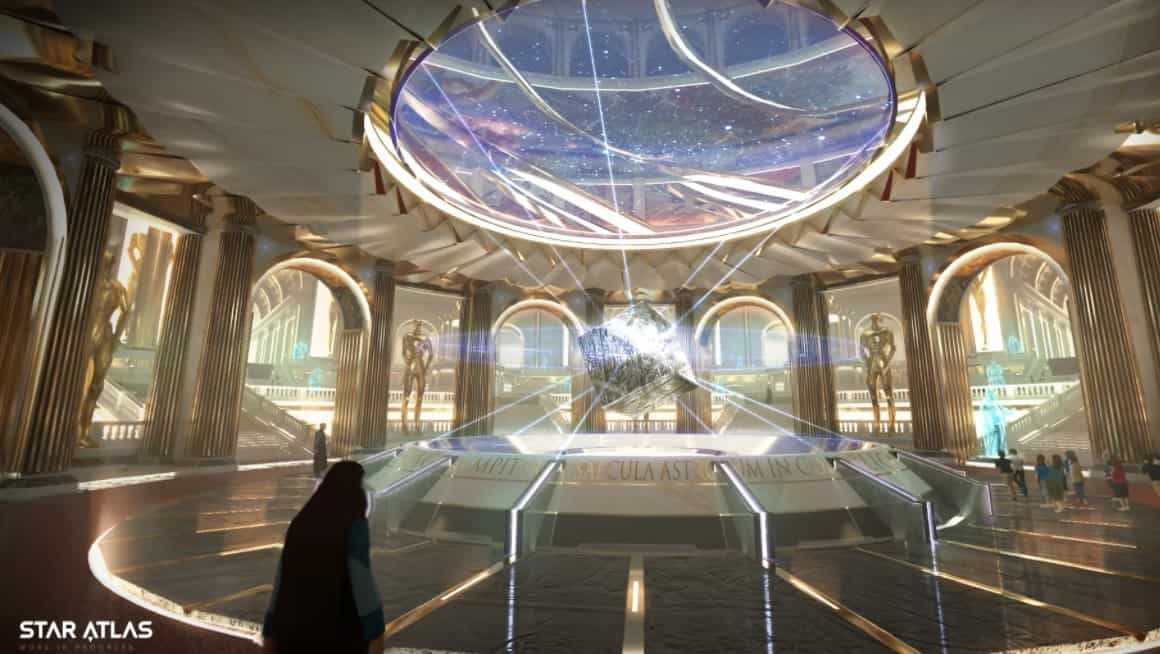
The potential that metaverses and play-to-earn games have to seriously impact and disrupt the real world is enormous and cannot be overstated. When one considers what makes a more exciting way to earn an income: Limitless possibilities, no physical restraints, not needing to obey laws of gravity/physics/thermodynamics, and exciting job prospects like space pilot/bounty hunter/explorer/pirate/soldier in a metaverse, versus jobs like folding clothes at a retail store, flipping burgers in a fast-food joint, or staring at spreadsheets sat at a desk all day, it isn’t difficult to figure out which one people are more likely to gravitate towards.
If the metaverse is going to eventually consist of everything we have in real life plus more, the number of jobs that will need to be filled in digital realms will be significant, potentially causing a mass exodus from the physical workforce, the likes of which we have already begun to see.
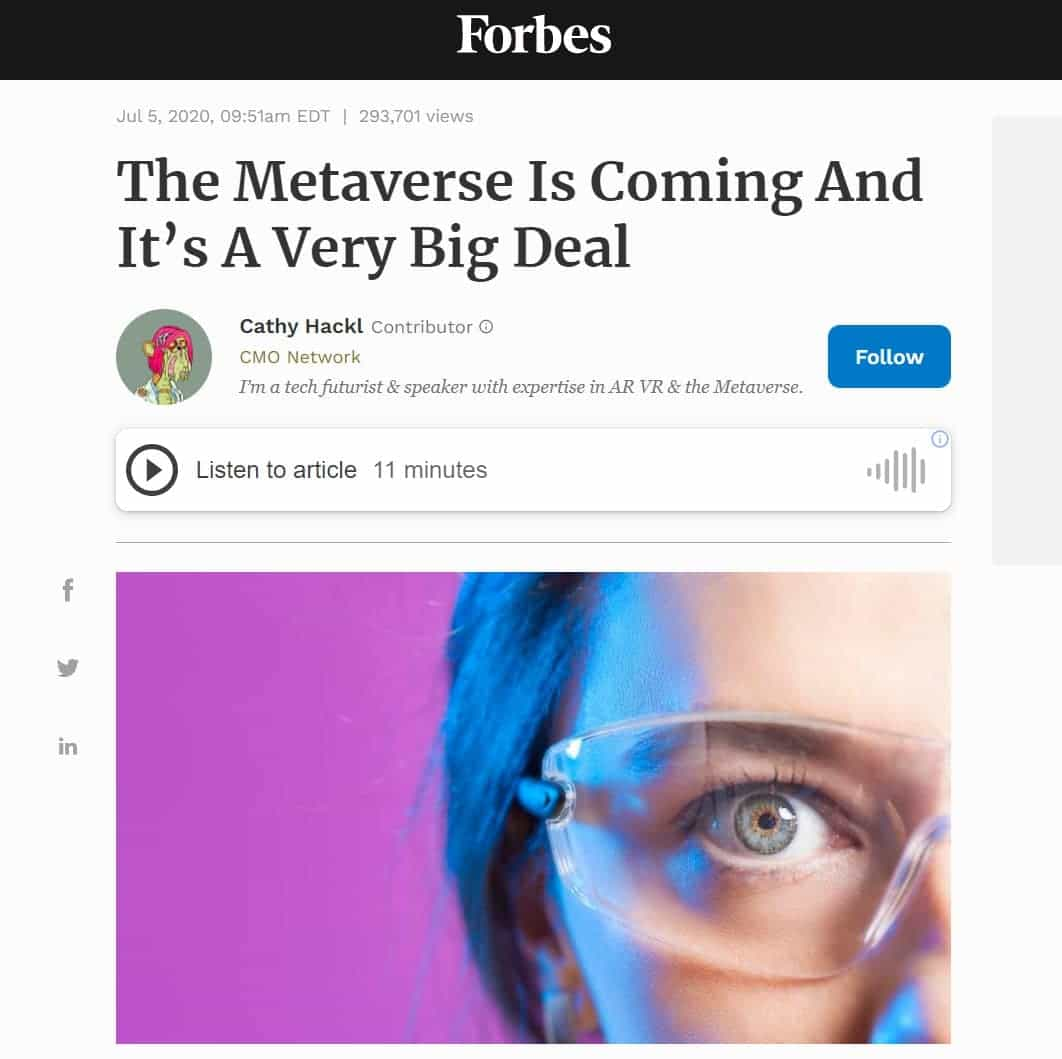
I explore this concept deeper regarding just how big of an impact metaverses and blockchain gaming can have on the real-world economy in my Play to Earn Blockchain Games and NFTs article and in The Future of Blockchain Gaming article.
Commerce will play a large part in metaverses as well, and Star Atlas will have cities and space stations where users can shop around, purchasing items for both in-game use and real-life items that can be shipped to your door. Some of the in-game professional careers highlighted in the whitepaper include things like:
| Mining | Rescue Crew |
| Pirating | Freight & Logistics |
| Bounty Hunting | Imperialism |
| Crafting | Retail |
| Ship Storage | Repairing |
| Refuelling | Refining |
| Defence & Security | Attacking/Defending Forces |
| Asset Brokerage | Node Staking |
| And More |
Closing Thoughts and Criticisms
I have been following this project for about two years now, and even after all this time, I am still awestruck and amazed by the vision and ambitiousness of the team. I feel like my mind starts to melt when I traverse down the rabbit hole of everything that may someday be possible in virtual worlds.
That is not to say that I am confident that this gaming metaverse will live up to the hype or become everything it has been made out to be. I think it is good to retain a healthy dose of scepticism and would like to highlight that there is a pretty decent chance that this project could end up being a colossal failure as their ambition may be too grand.
Much like Icarus in Greek lore who flew too close to the sun, the Star Atlas team may be biting off more than they can chew. Star Atlas has some intense competition in the space, it is impossible to know for sure which ones will triumph and which ones will falter. The collapse of FTX was also a serious setback for the project as much of the project's funds were tied to the now-defunked exchange. Though on the flip side, metaverse VC giant Animoca Brands is one of the backers, which gives me that much more confidence in this project.
I think that it is also important to point out that many metaverse sceptics feel that what Star Atlas is trying to achieve is not even be possible with the current technology we have available and that we are unlikely to see a fully immersive metaverse like what Star Atlas is trying to create in our lifetime, and a part of me agrees. Current VR technology is nowhere close to being where we need it for a project like this.
Still, as the team has pointed out, Star Atlas will be ever-evolving and rolling out in stages, just how early days of the internet resembled nothing like the internet we have today. Yet, people still used it in the early days, and we continue to evolve with it. I just want to be realistic in stating that a lot could cause the project to fail between now and the launch, which is still years away as I am not in the business of hyping projects or fuelling hopium. However, I must admit that what the Star Atlas team is attempting to create and achieve is truly awe-inspiring.
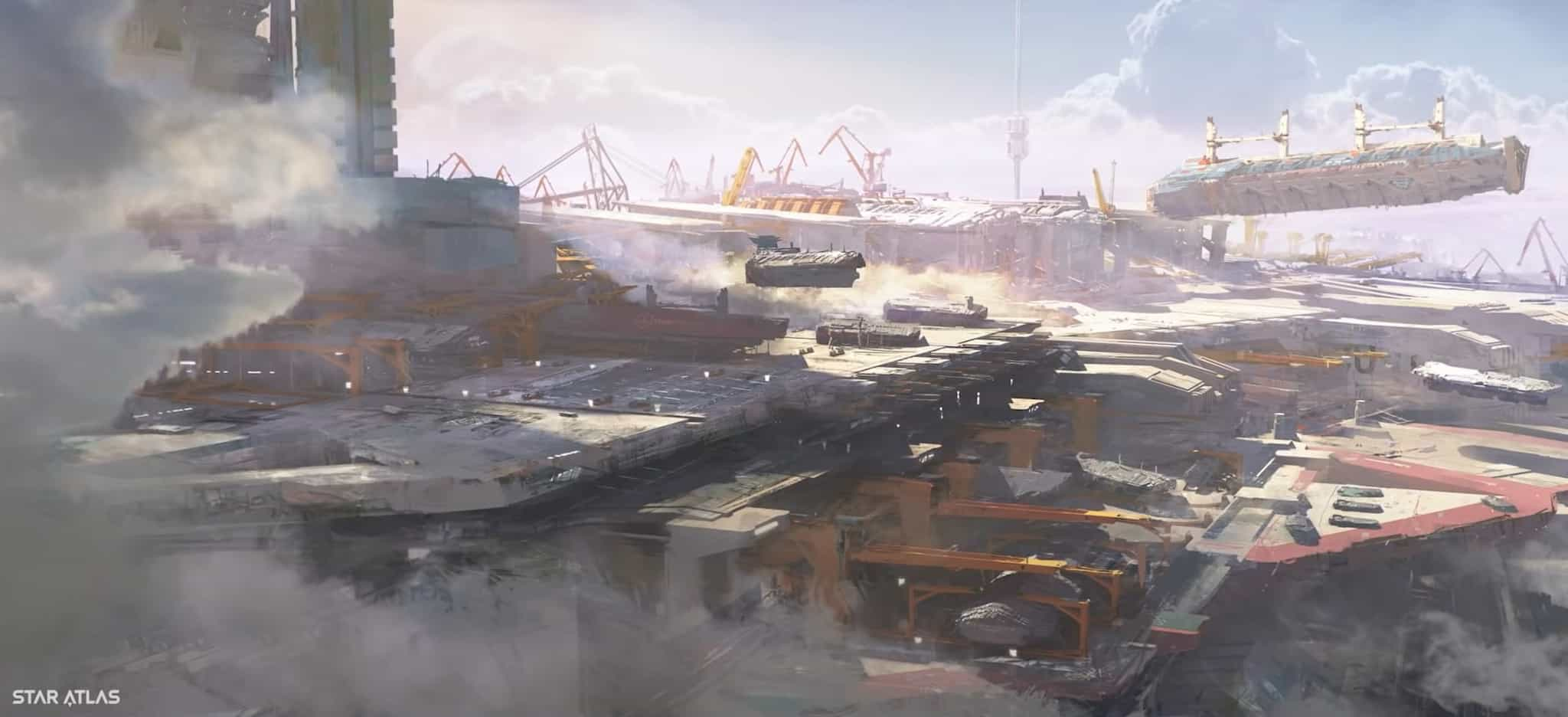
Never before has there been such a mountainous task attempted by a team to design and build a digital world, nor has anything like this ever been possible before the development of blockchain technology. Whether or not Star Atlas will become THE main metaverse that humanity chooses to frequent is yet to be seen, but this is the first project I’ve seen that looks like it could bring us the closest we’ve come to virtual worlds seen in sci-fi movies like Ready Player One or The Matrix.
There is no shortage of excited gamers, metaverse enthusiasts, entrepreneurs, companies, investors, and VCs lining up to get involved in Star Atlas. The popularity and hype around the project are gaining speed at astonishing rates. If this game lives up to even a fraction of the teams envisioned potential, this metaverse gaming project could have a serious impact on the lives and finances of players, users, and investors, along with the global economy. This project is definitely worth keeping on your radar. I know I will follow the team and project closely as a project of this magnitude does not come along very often.
Disclaimer: These are the writer’s opinions and should not be considered investment advice. Readers should do their own research.


